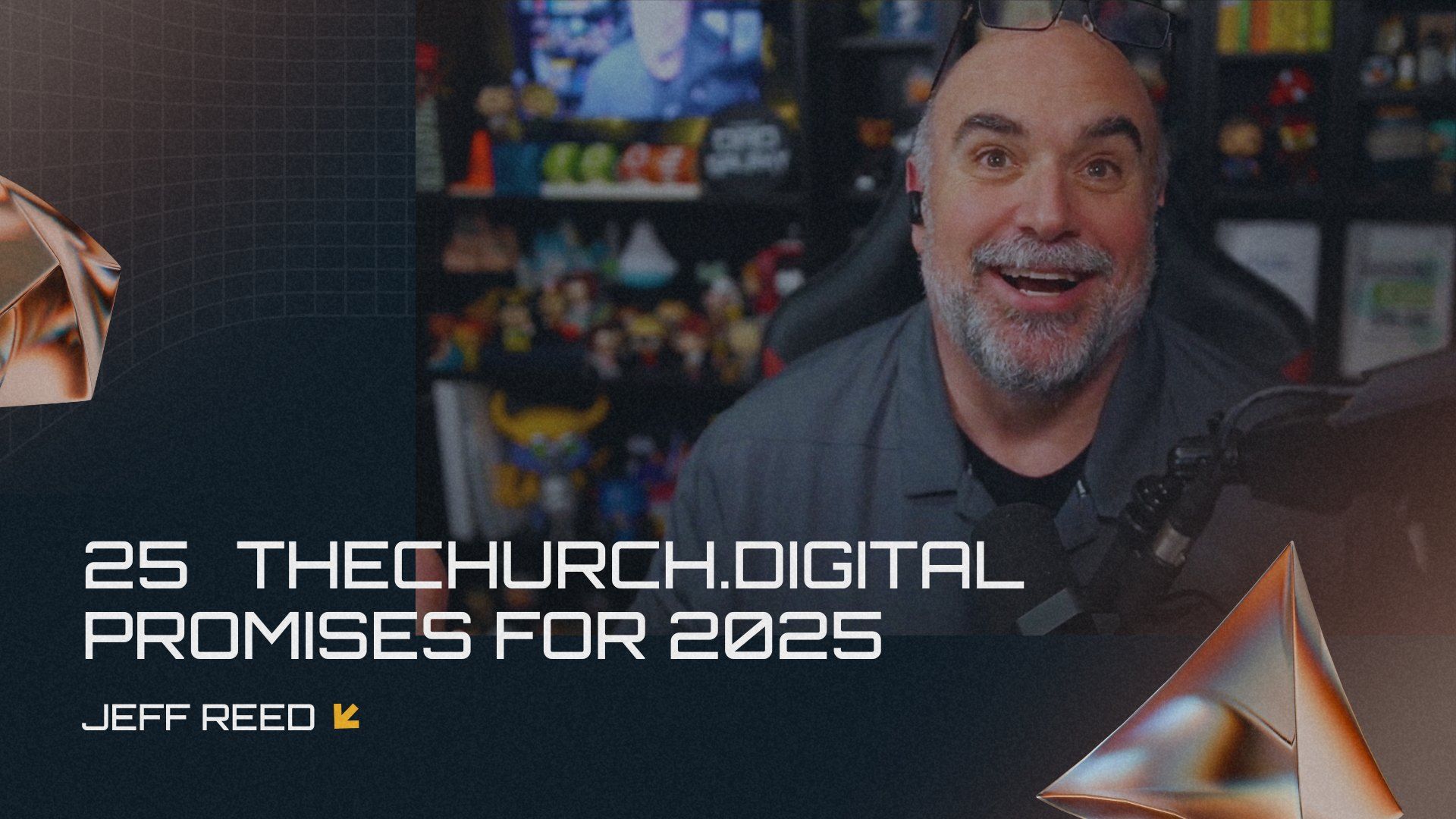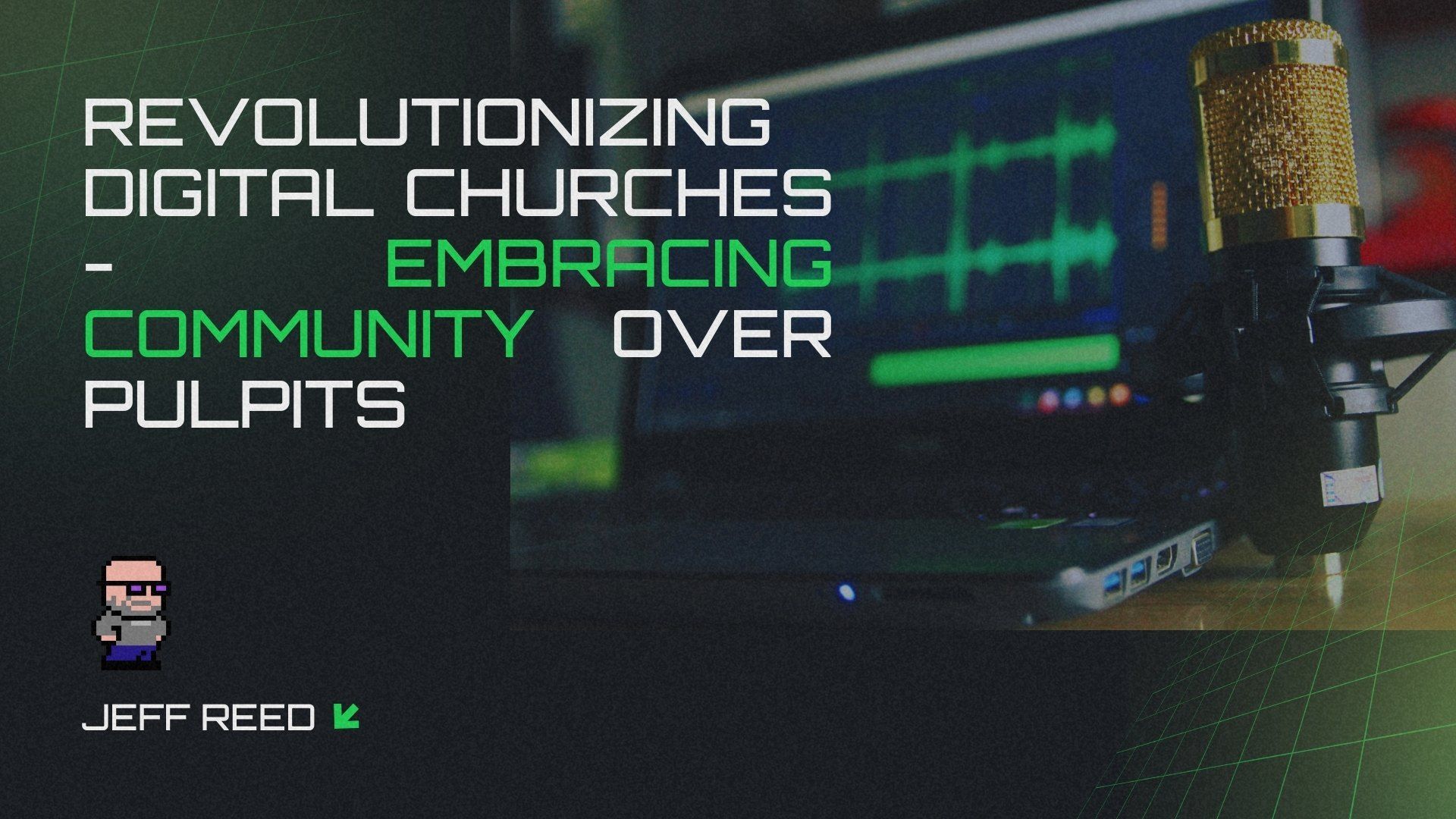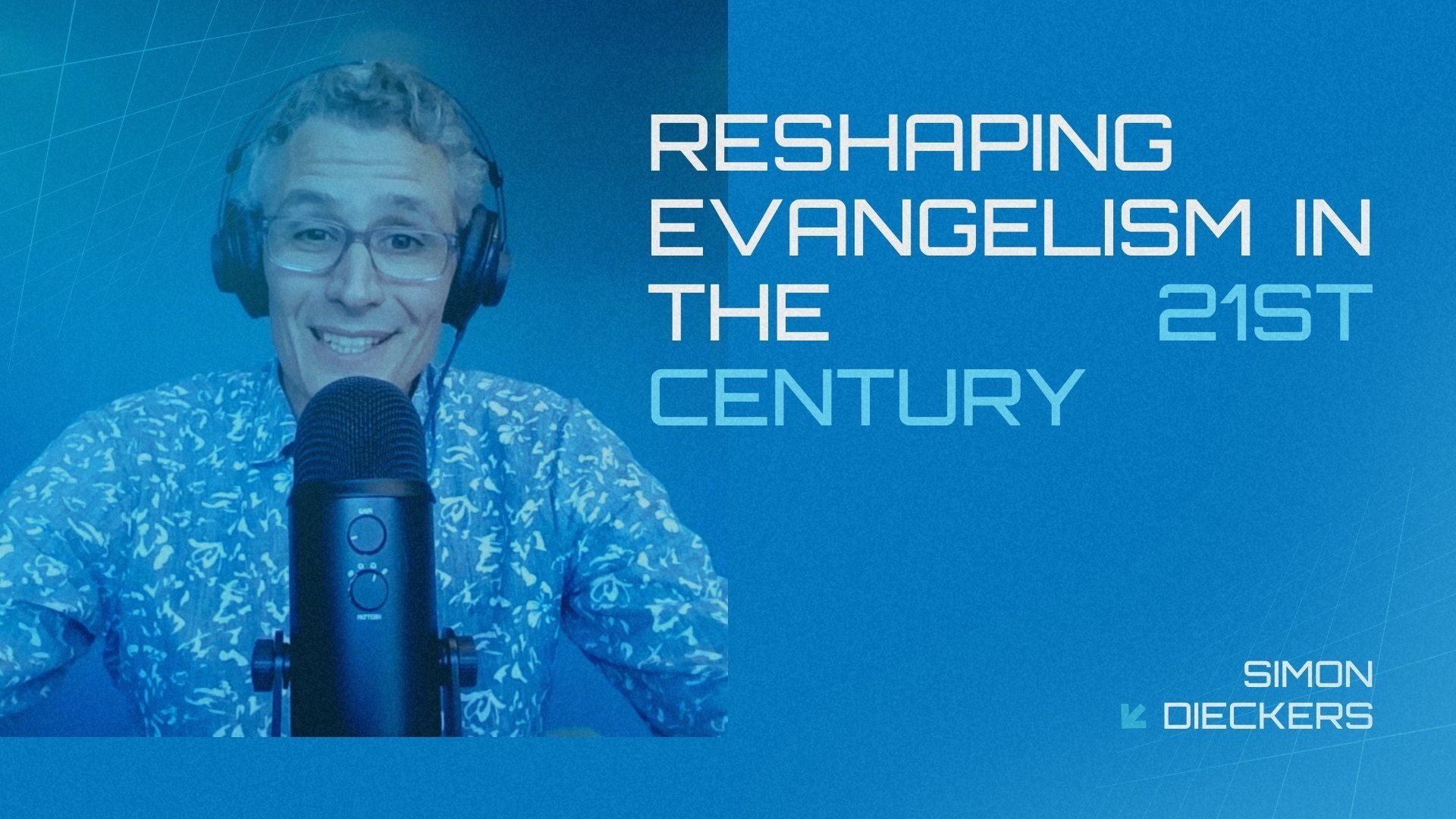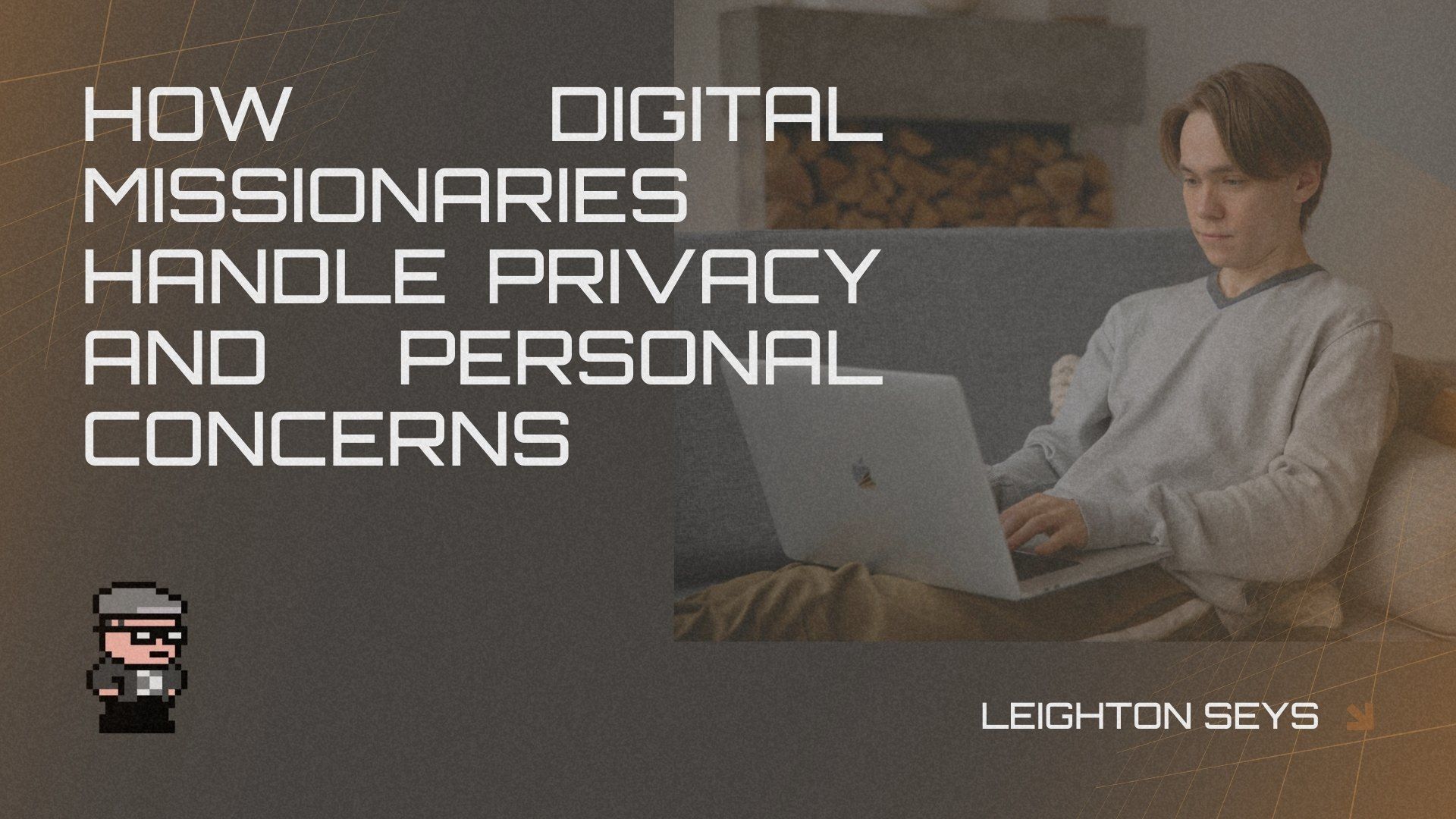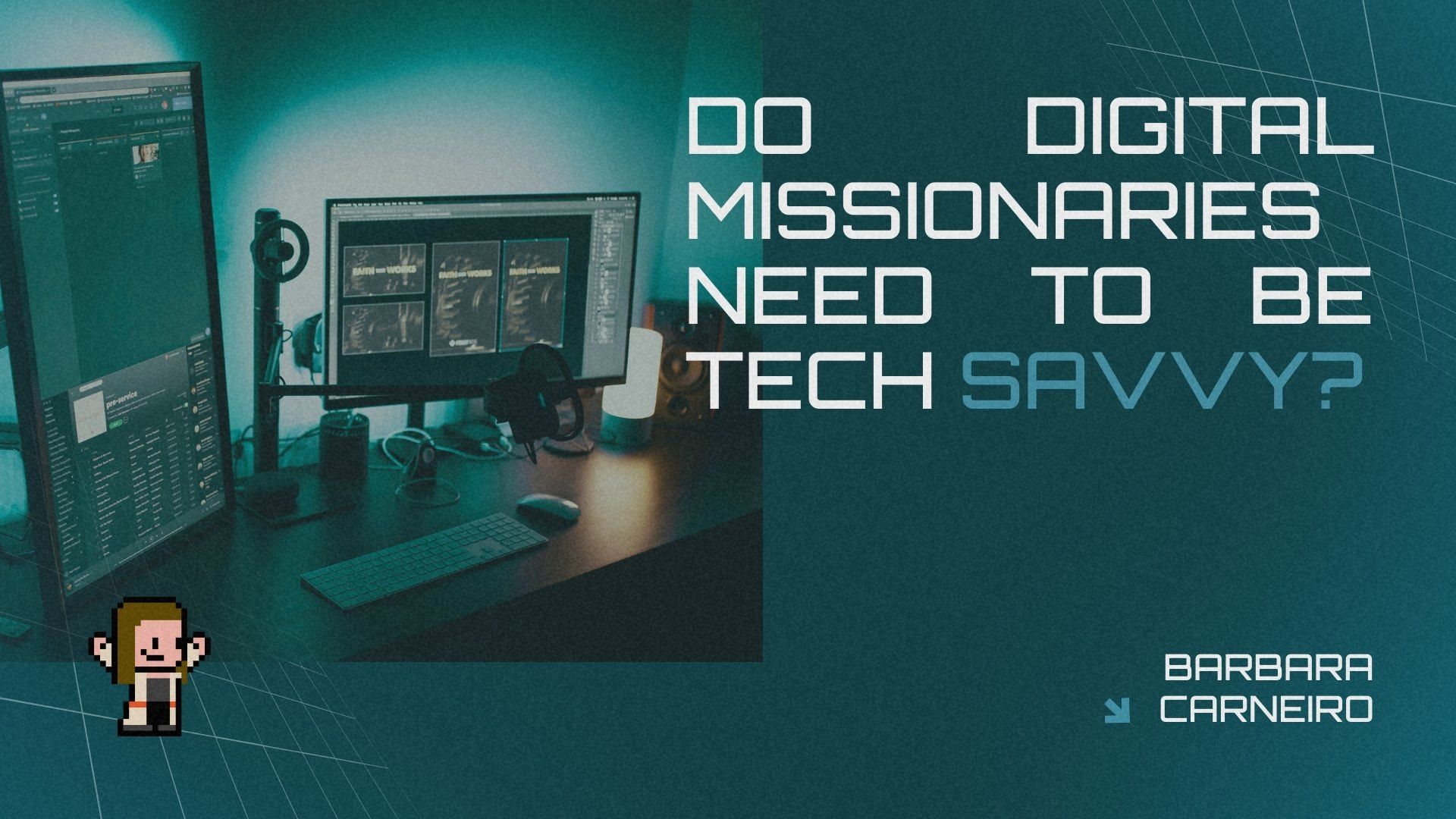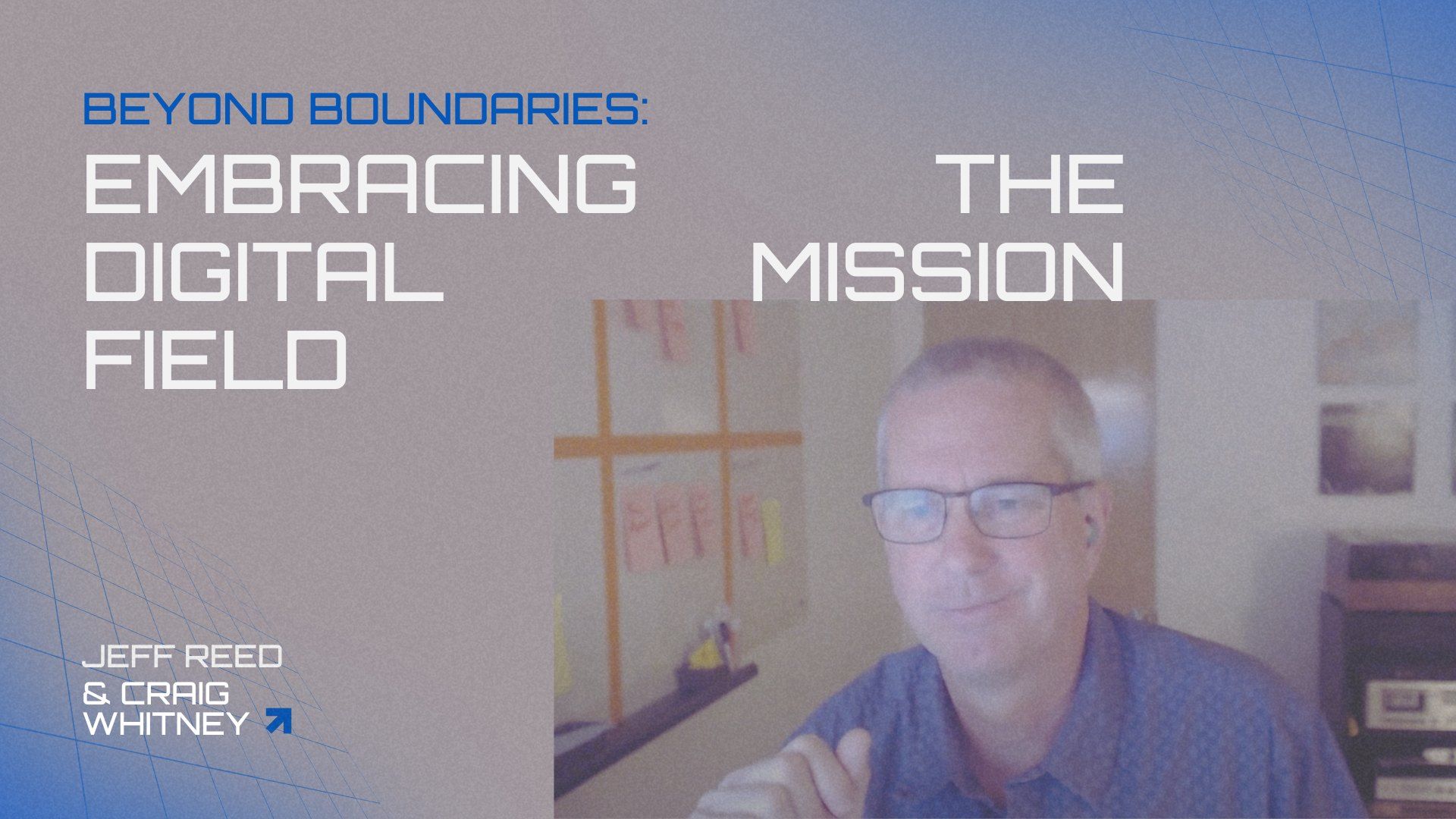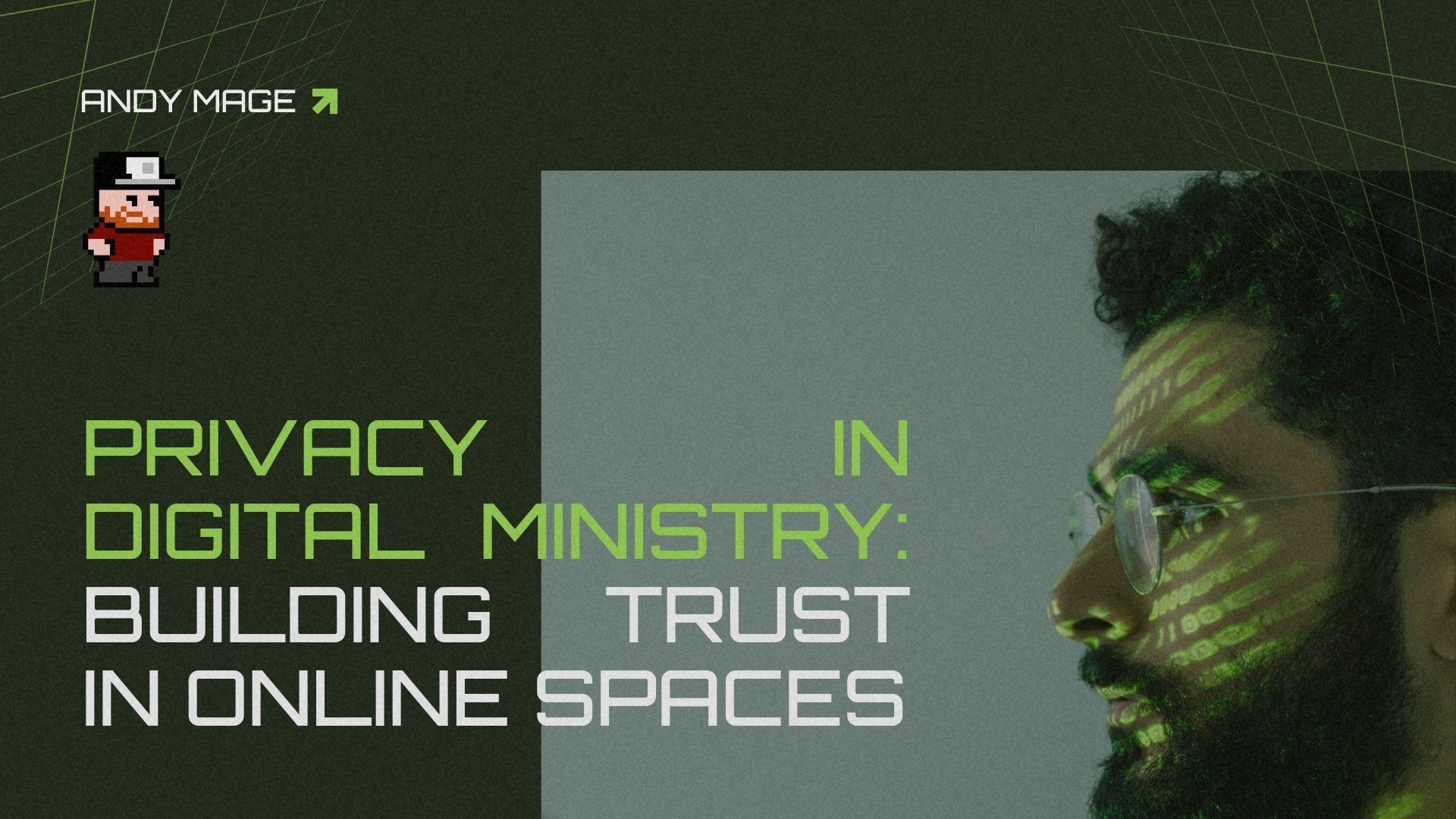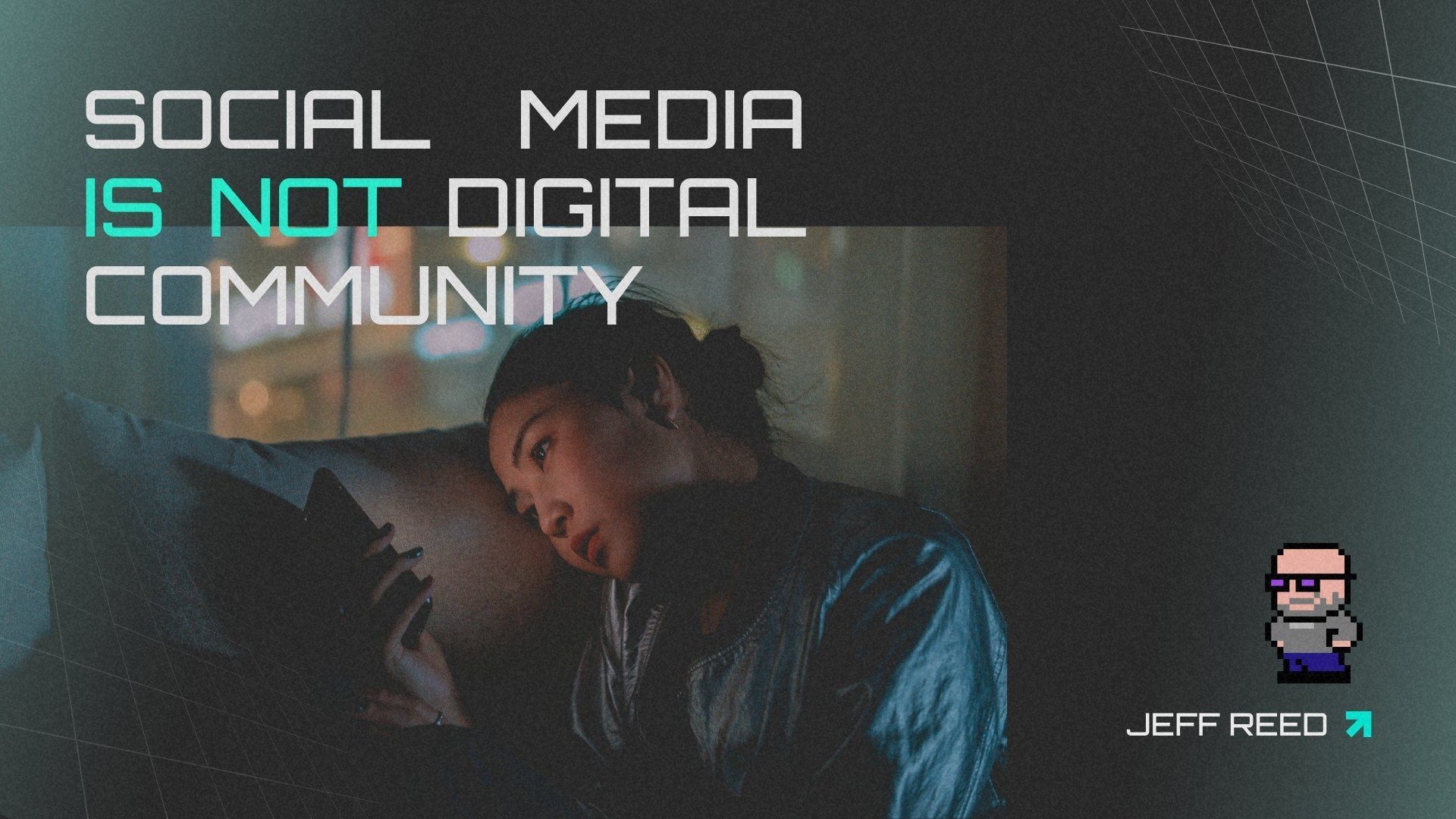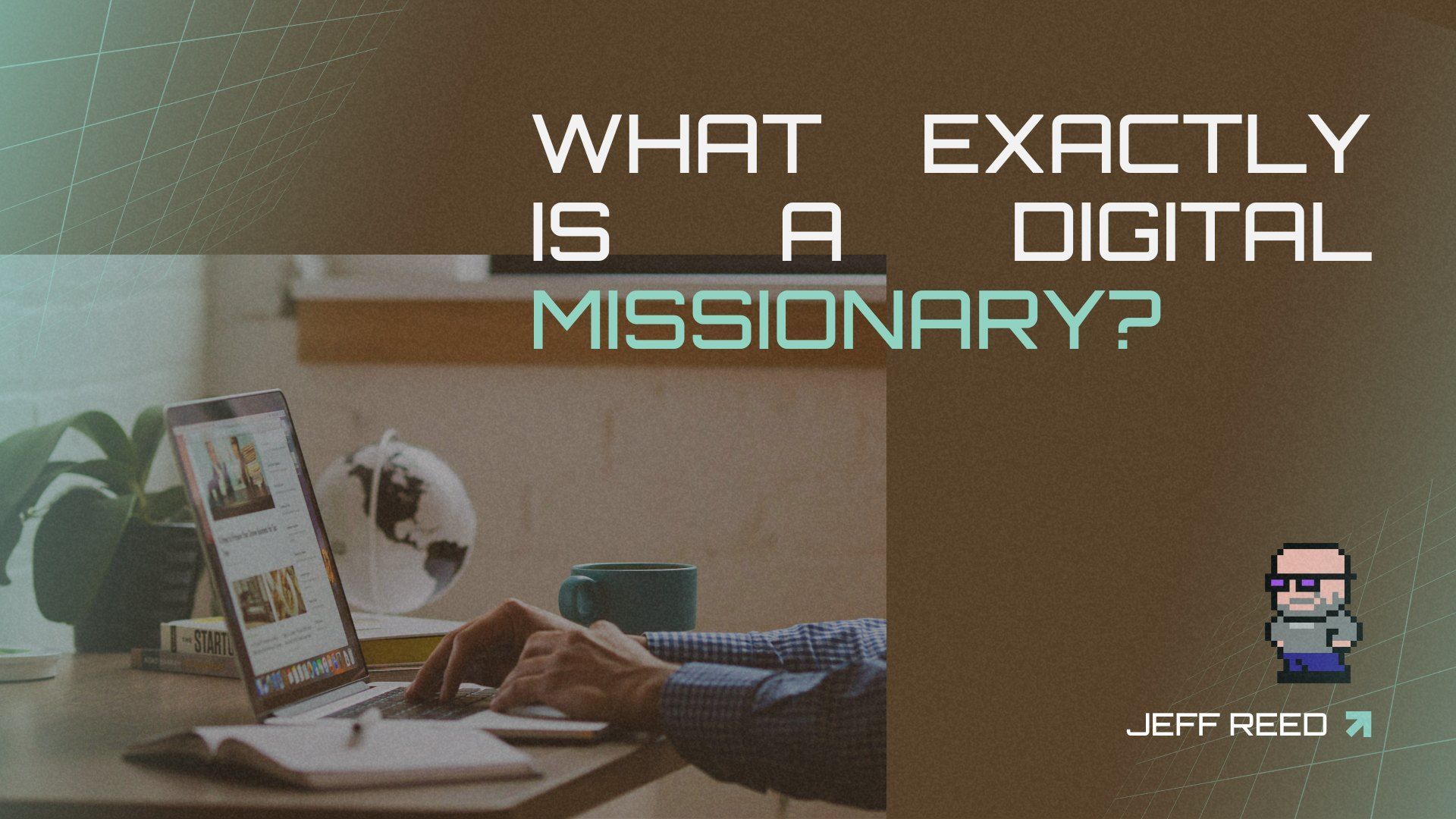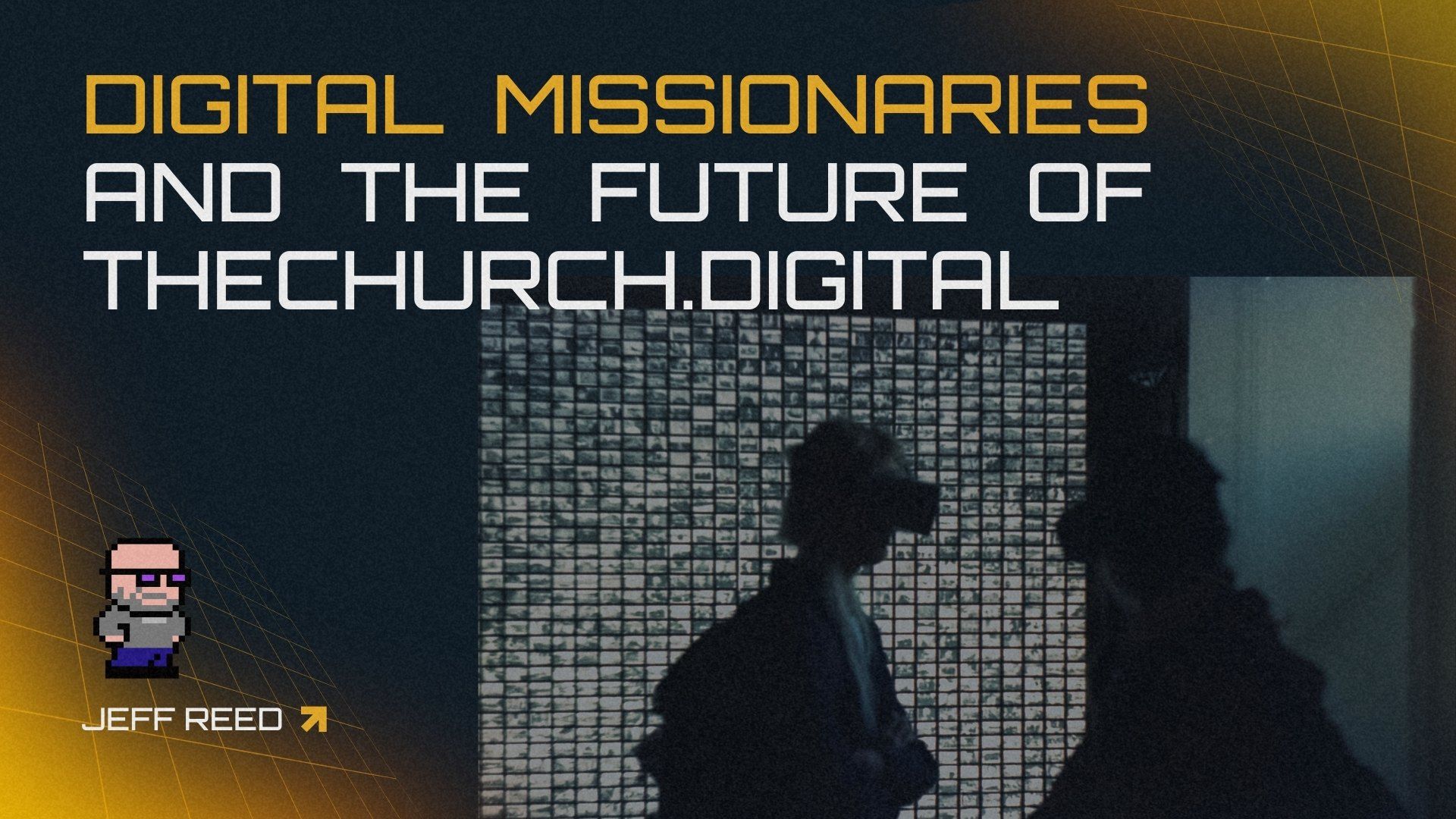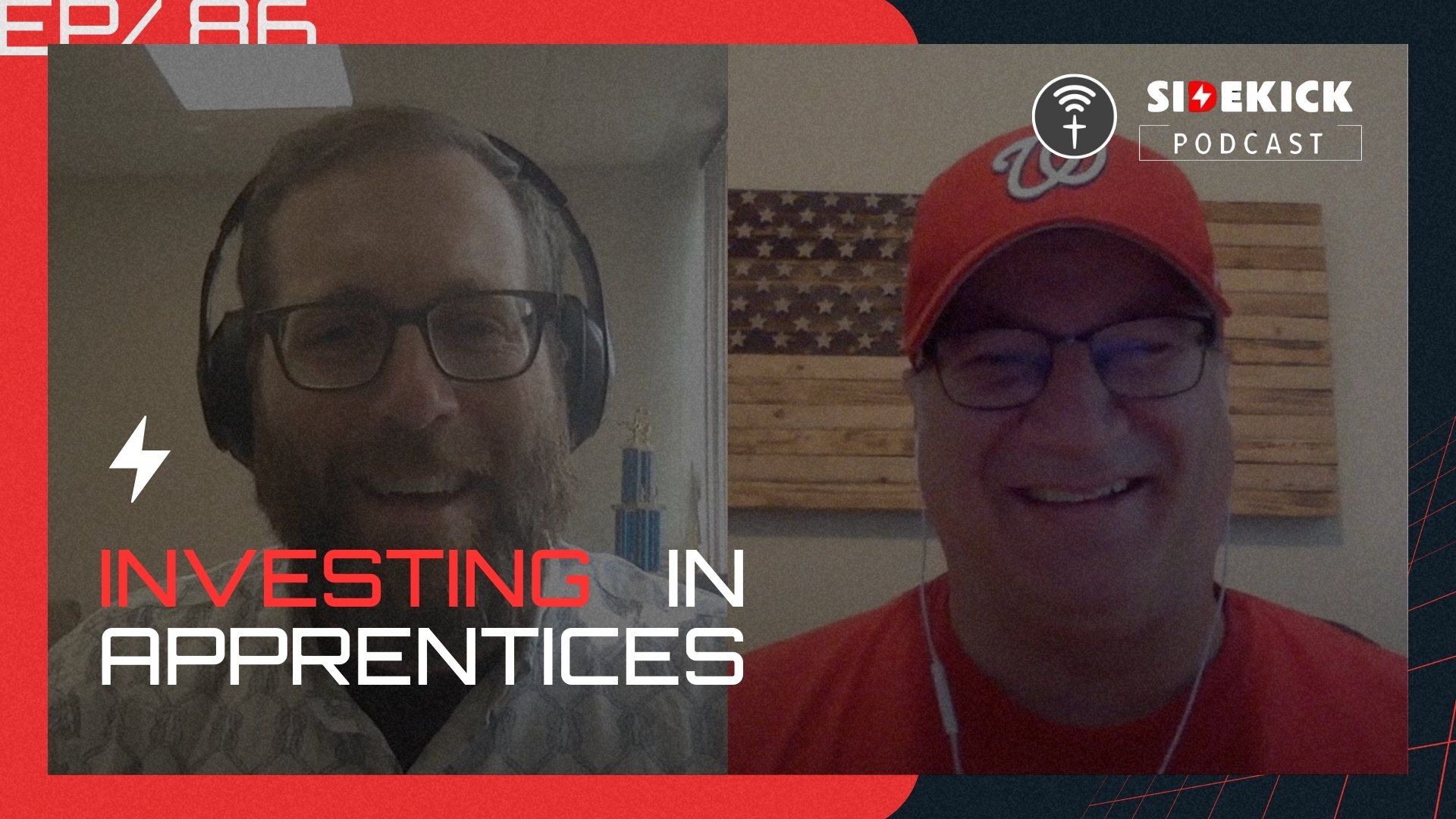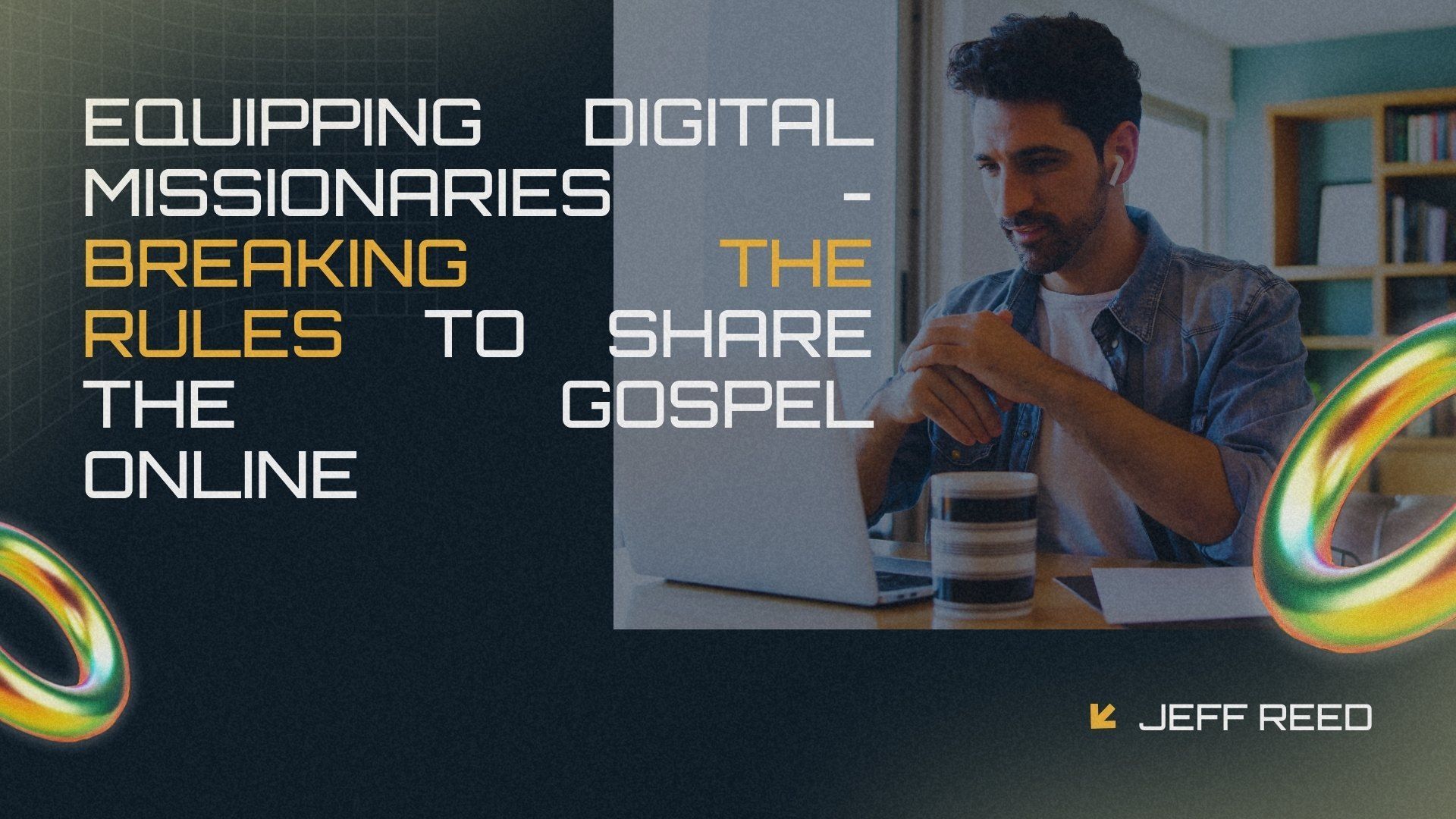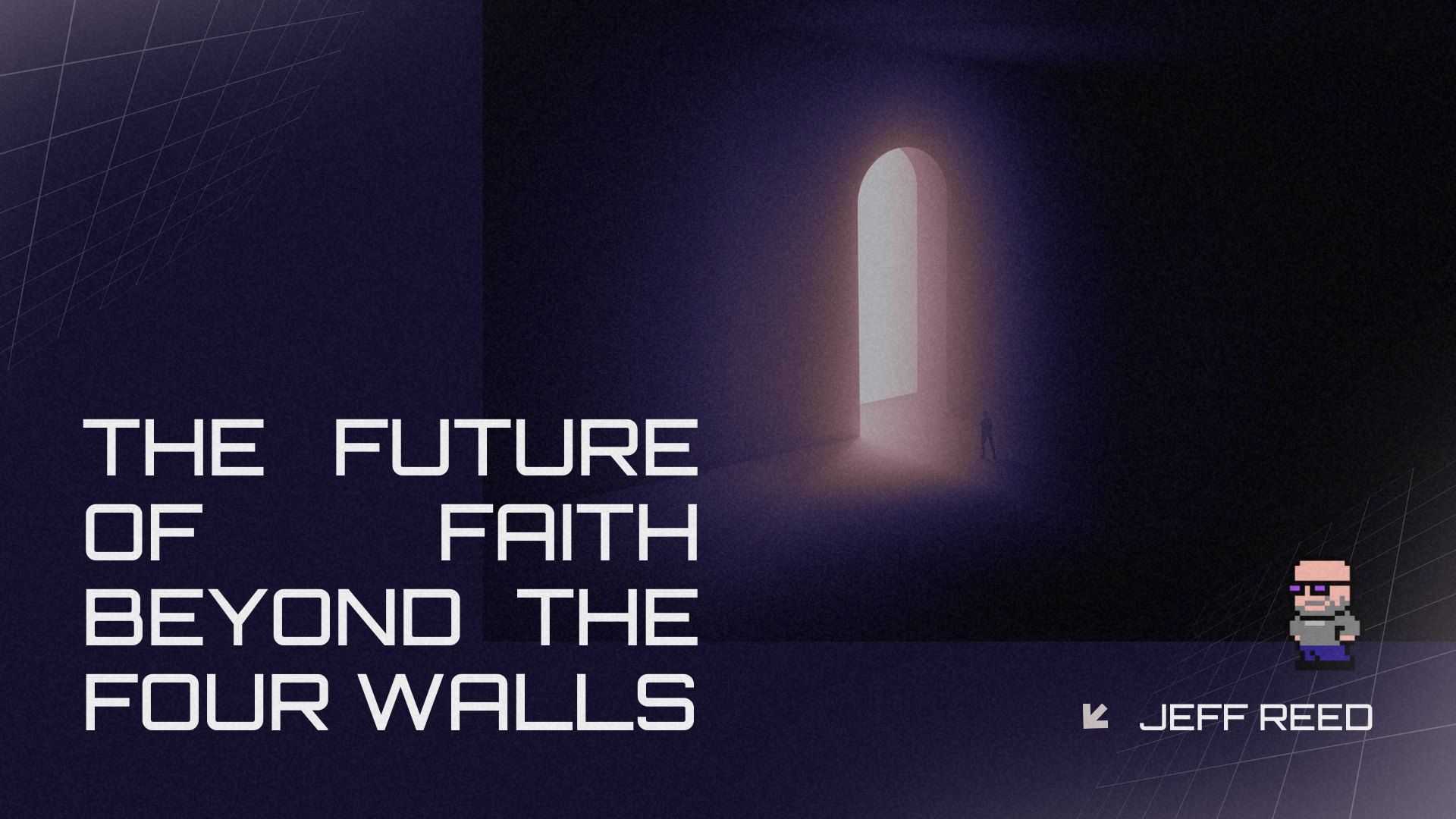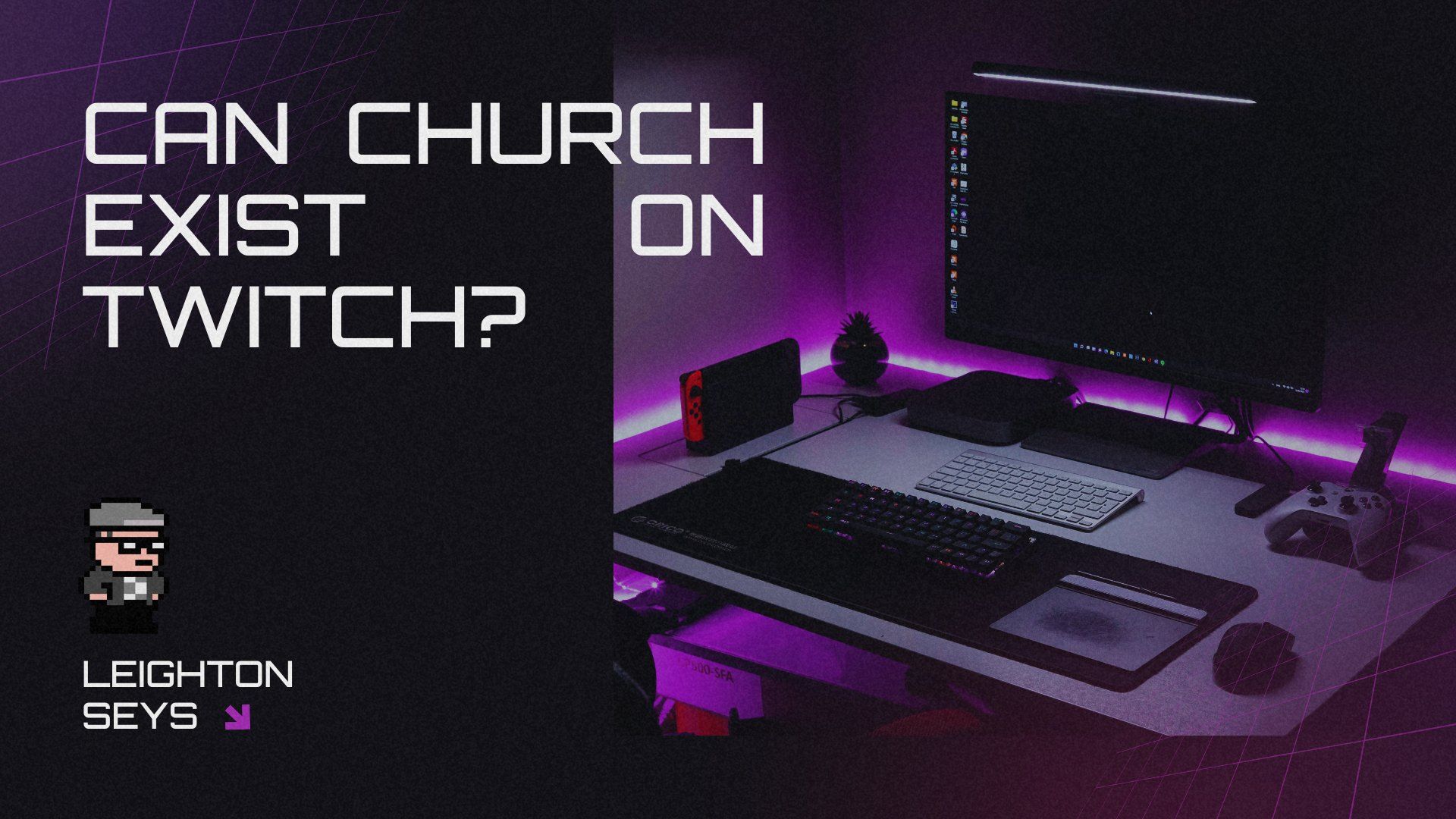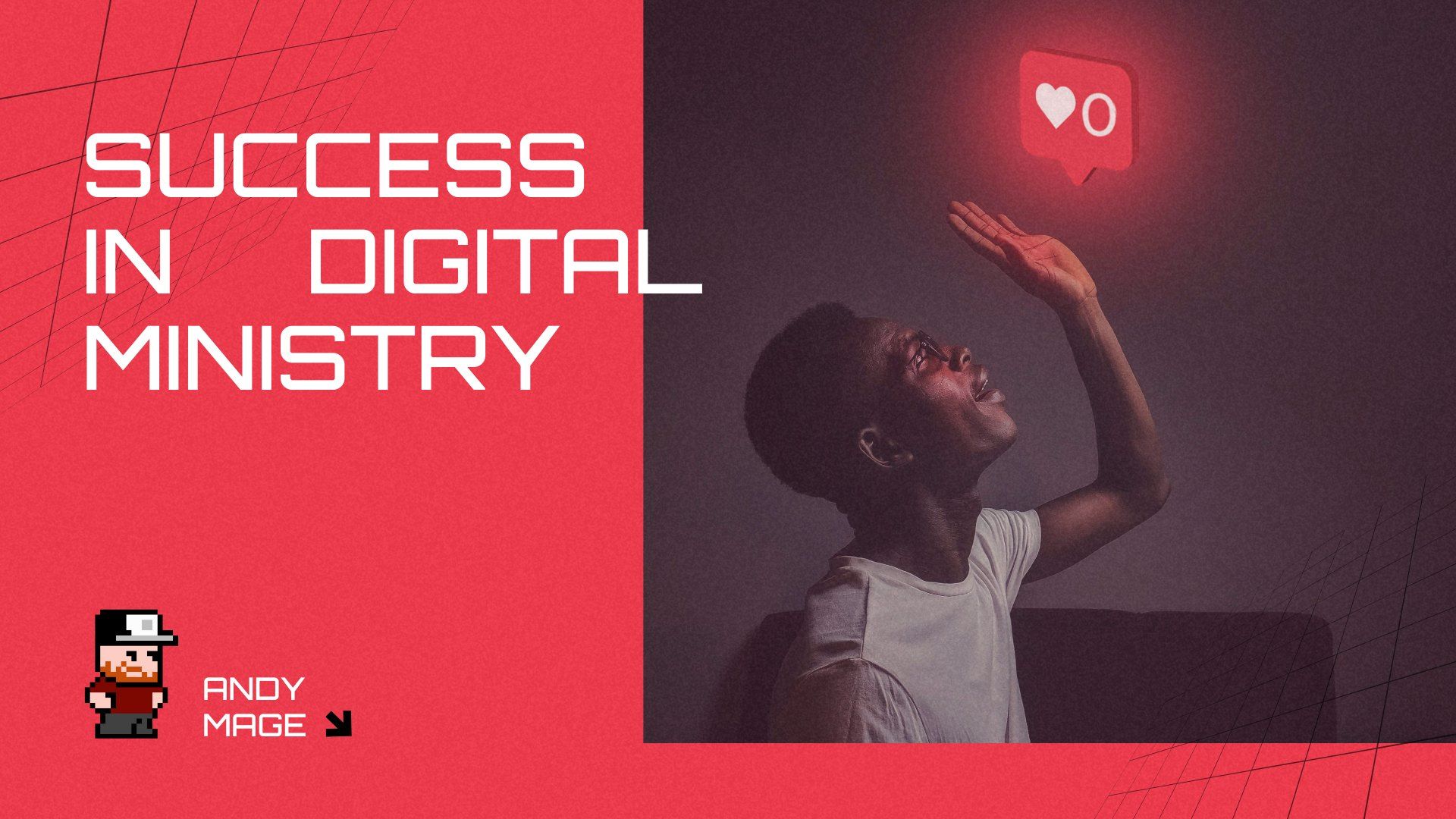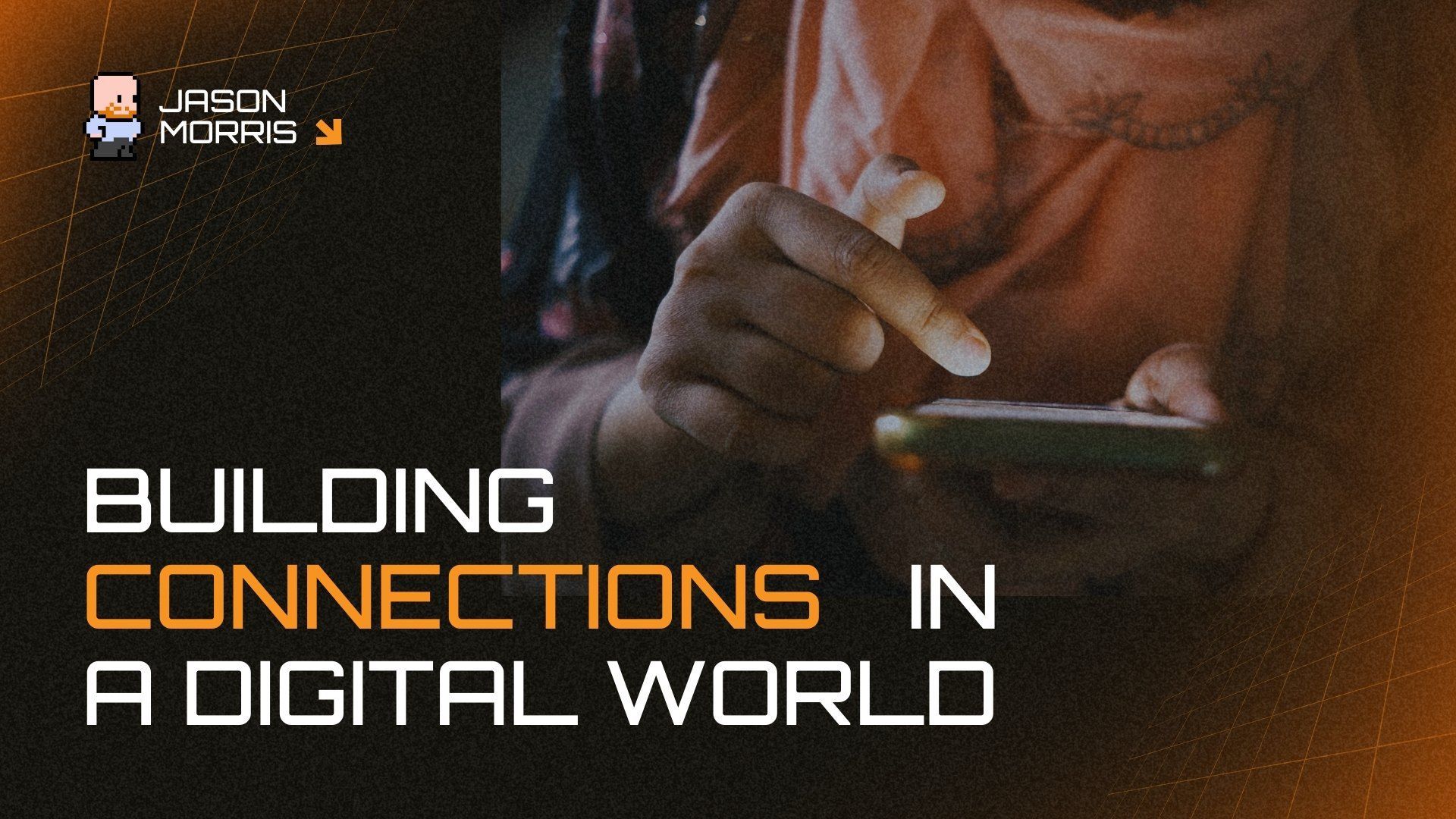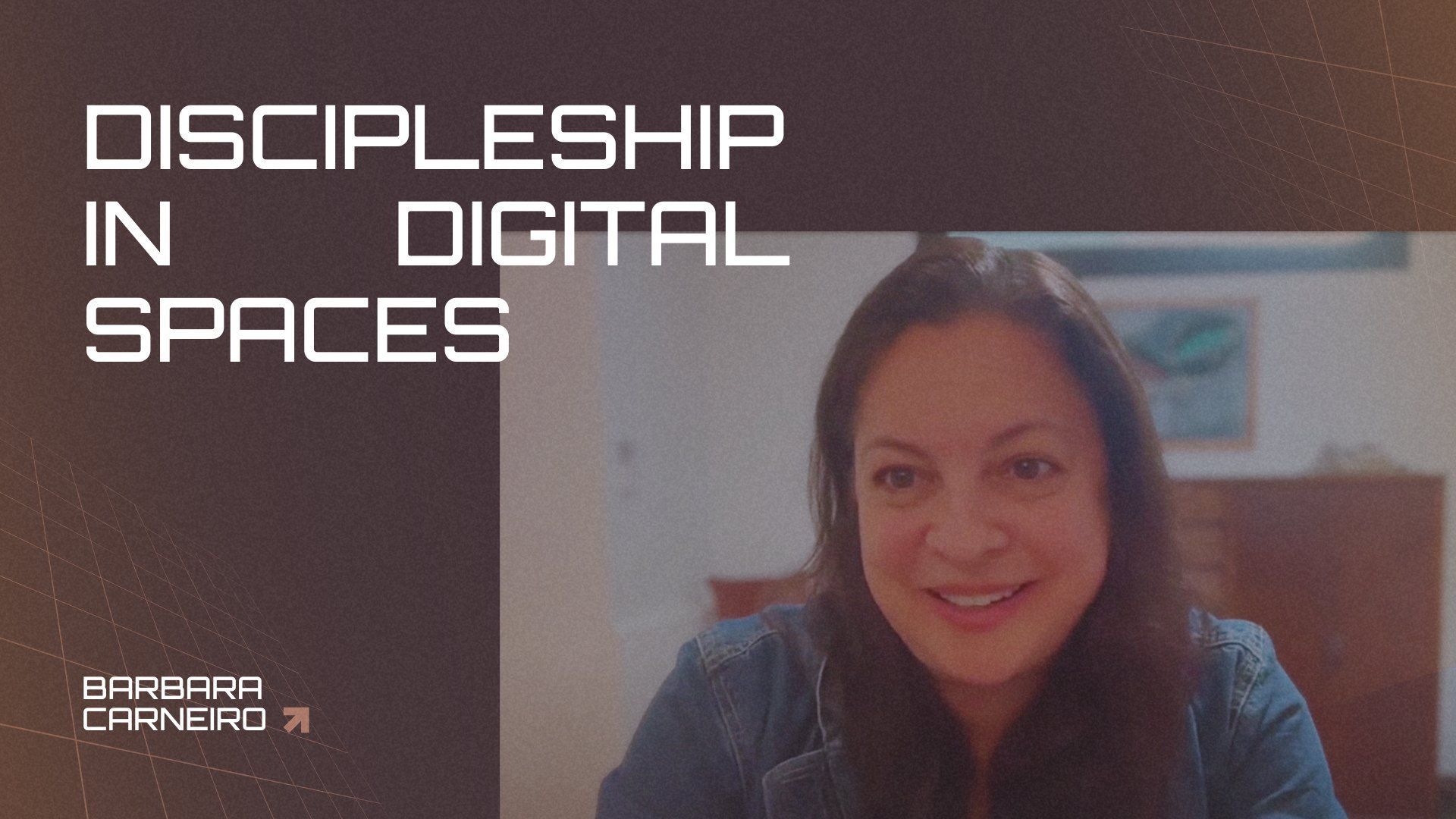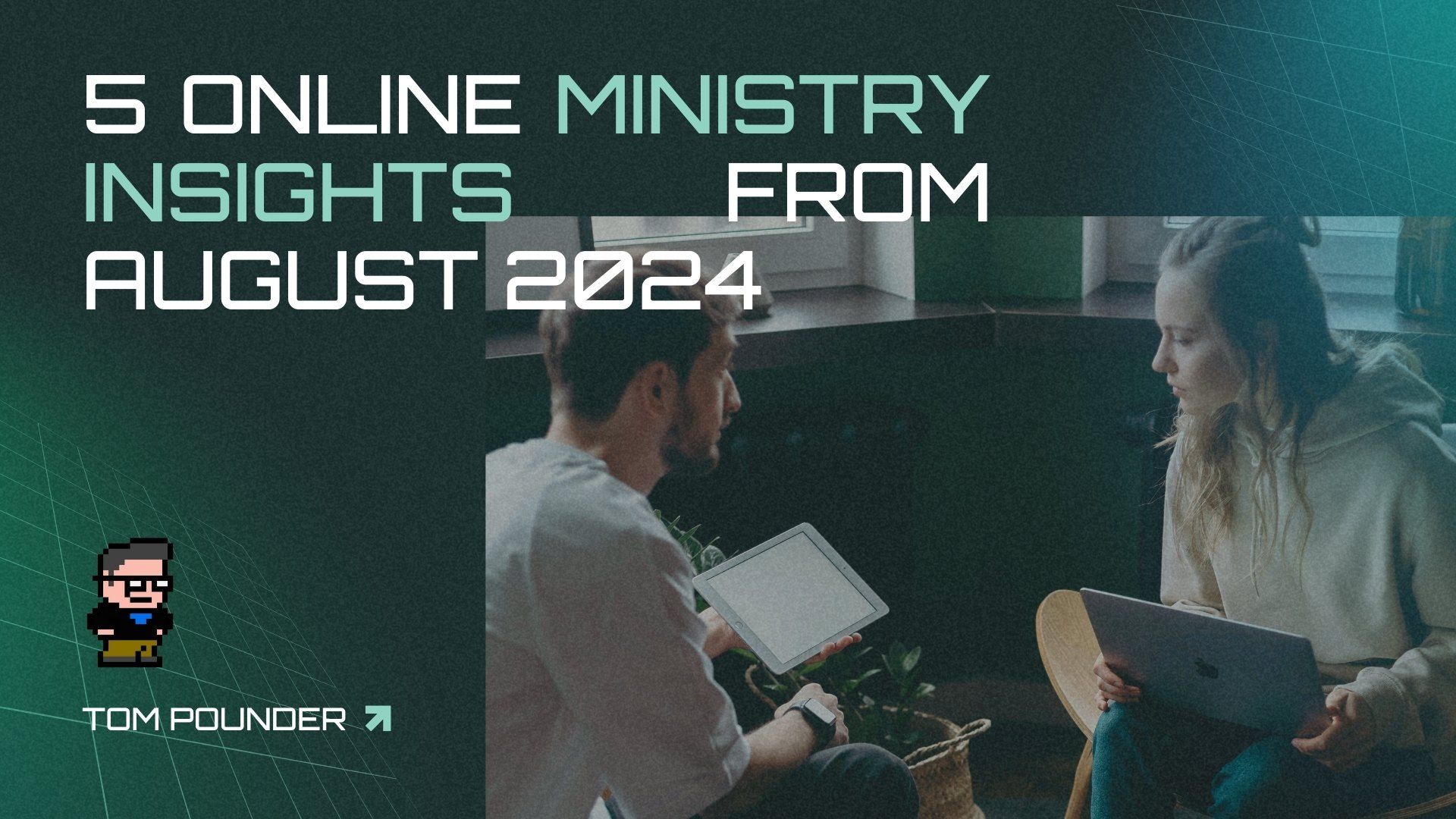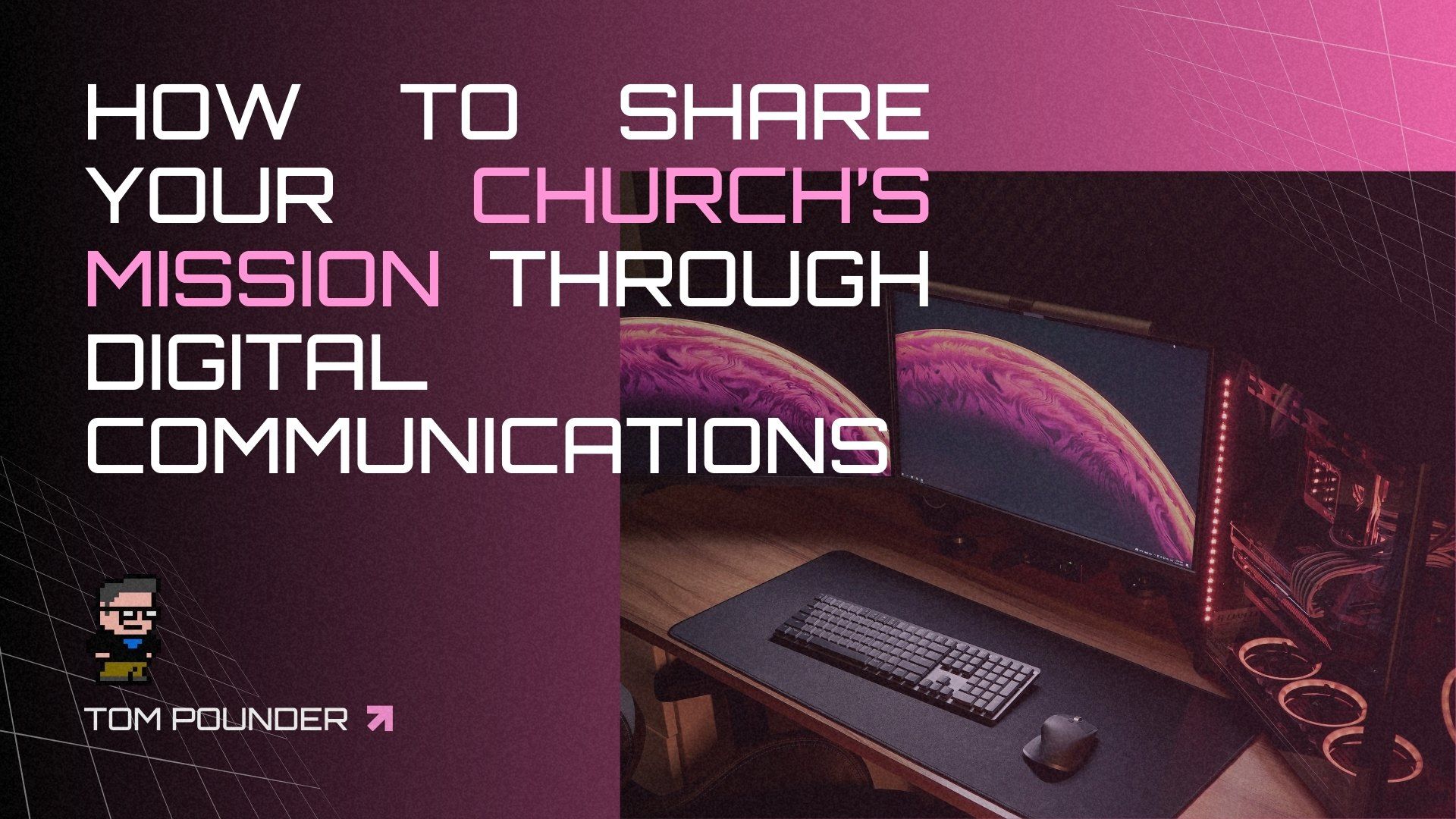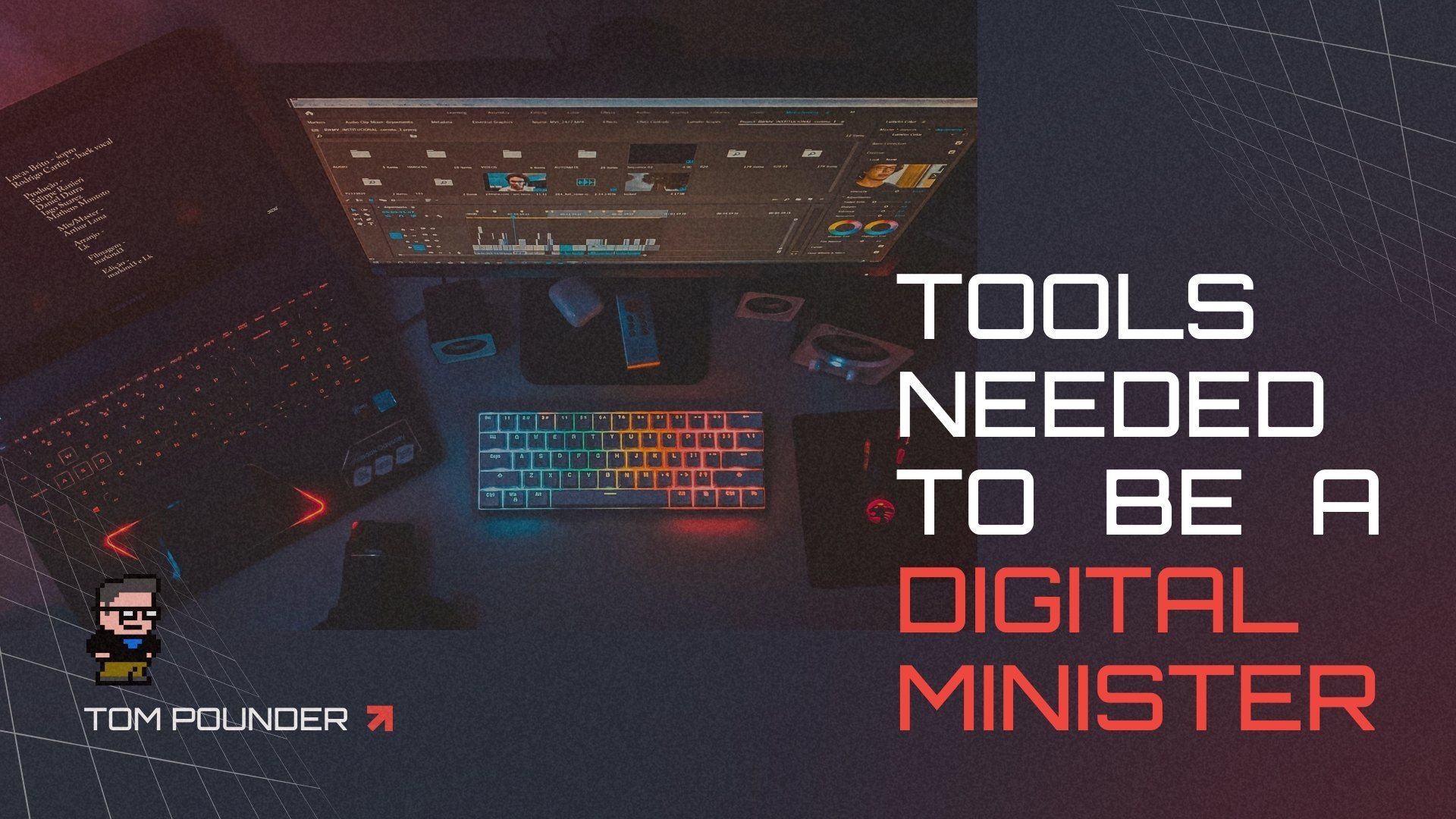PODCAST 034: Jim Tomberlin - Trends of Multisite & Church Online
The idea of the multisite church was born in the 1990s as church attendance was growing faster than the church buildings could sustain. Even in those early days, there were questions about the validity of the Multisite Church Model, Time has worked in multisite’s favor, though, as a “radical” idea 20 years ago has turned into a “cool” idea 10 years ago, transitioning into a widely accepted “mainstream” idea today.
Church Online is on a similar path. Early pioneers started making Church Online a reality about 10 years ago. What was a radical concept in 2009 is trending towards the “cool” church thing of 2019. Will it make it to “mainstream” in 2029?
This is the question we asked Jim Tomberlin, Chief of Staff at Christ Fellowship Miami and founder of Multisite Solutions. Jim has had a rich history as one of the early pioneers of multisite in the 90s, eventually joining staff at Willow Creek in the mid-2000s, helping them transition to the multisite model. Through his company, Multisite Solutions, Jim has influenced hundreds of churches going multisite. His depth of understanding on multisite strategy is phenomenal.
Multisite church has driven a lot of innovation for the church in recent years. What does Church Online need to do to turn the corner and follow in the path of big brother multisite? All this and more on Episode 34 of The Church Digital Podcast .
If you're enjoying this episode, subscribe for free using your favorite podcast app below:
Apple Podcasts | RSS Feed | Anchor | Overcast | Spotify | Pocket Casts | Google Play
ON THE SHOW
Guest: Jim Tomberlin
Christ Fellowship Miami
, Chief of Staff
Multisite Solutions
Twitter
// Facebook
// Instagram
Host: Jeff Reed
THECHURCH.DIGITAL
Twitter
//
Facebook
//
Instagram
//
LinkedIn
Co-Host: Rey DeArmas
Christ Fellowship Miami Online
Twitter
//
Facebook
//
Instagram
SHOW NOTES
- Multisite Solutions Team
- by Jeff Reed
HELP ANOTHER CHURCH. LEAVE A REVIEW.
TRANSCRIPT
Jeff Reed: 00:00 Hey everybody. Welcome to The Church Digital Podcast. My name is Jeff. You've got Episode 34 and I'm going to tell you right now, I have been waiting for you all to listen to this podcast for a long, long time. One of my favorite ministry-minded people right now is going to be on this podcast. We've got Jim Tomberlin here today, joining us. Multisite Guy is his moniker in social media online and he's been inspiring people for decades in context, especially around mergers and multi-sites. He's been one of the early innovators of multisite, Jim and his company. You may have known from Multisite Solutions. It's got a track record with Willow Creek. And honestly, he's been inspiring me for quite a while, even before I met the guy. He's been an inspiration for me, centering around this idea of church and multi-site, decentralizing ministry and making it a scalable solution that can get out there.
Jeff Reed: 00:55 But you're probably asking this question, so what is a fan boy of church online, somebody like me, get obsessed with this idea of multi-site? Well, honestly, you're just going to have to listen to the podcast to really enjoy and appreciate the track of what's happening here. So join me, Jeff with The Church Digital, along with Rey, Online Pastor at Christ Fellowship Miami, as well as, Jim Tomberlin, who is Multisite Solutions, as well as, Chief of Staff with Christ Fellowship Miami in an episode discussing the similarities and the trends between multi-site and church online. Everybody, here you go. So Jim, I know obviously you have a very rich history in the church, but a lot of it's tied to this idea of multisite. So man, just tell me a little bit about your story of how you grow multi-site.
Jim Tomberlin: 01:41 Well, my journey with multisite church began back in the mid nineties when I was a Senior Pastor in Colorado Springs at Woodmen Valley Chapel. I wasn't the original pioneer, but I was one of the original pioneers of this idea and it really was birthed out of a space restriction, which is how the multisite movement began. I came to a church of 400 people and over the first year I grew it down to 200 while it grew to a thousand, you follow me? Several years later, several thousand people later, we're out of room and out of space and so how do we solve a problem where we have no more room to grow on this location? It's a great location. We don't want to relocate. I in a few others around the country unknown each other began to experiment with this new idea of video that maybe we could be one church in two locations. That eventually got me invited to leave Colorado Springs and come to Chicago to Willow Creek to develop the multisite model there in the year 2000. I was there for five years and I launched the first four campuses of Willow Creek.
Jim Tomberlin: 02:36 Five years later, four campuses later, I was getting a lot of calls from churches around the country. How could you come talk to us about it and at that point I believe that accomplished what God brought me there to do. My next chapter was to help, was to serve the church, the big C church and this idea. Not thinking it lasts maybe three, four years, 15 years later, this model exploded, you know, just kept growing and morphine and more and more churches, doing this. And I was, growing with it that brought me here to Miami where we're sitting here now. And, working with was started to be my client and now still is my client. I'm serving now in an Interim Chief of Staff role here. And I've also recently merged my company, Multisite Solutions with my longterm friend and strategic partner, Tony Morgan and The Unstuck Group.
Jim Tomberlin: 03:22 And so that's been my journey with the multisite movement and it has been as I watched now what's been happening and I've been a big advocate for the online campus. It's a very similar journey, new ideas, innovative ideas like multisite, like the online church concept always started out as a radical idea that, and we saw this in the multisite movement and see it and now with the online is that it's gone from a radical idea to the cool idea, a into a cool idea becomes a mainstream idea. And so I see that pathway, unfolding by the online campus as well.
Jeff Reed: 03:56 Where did the, in the nineties I was a high school kid, I was playing football somewhere. I wasn't keeping up with church trends, but where did this idea of multi-site come from? Like where was the, the birth of it and how did it kind of build from there?
Jim Tomberlin: 04:10 Nobody was all meeting together and say, let's do a church a different way. It was really the beginning of the, with this movement really, it was a bandaid strategy for mega churches who found themselves out of room or out of space. That's what started me down this path in the mid nineties in Colorado Springs when my church grew to several thousand people. And we built out everything we could on our property that we were on and we were still growing and turning people away. And so what do you do in the mid nineties when you're out of room and out of space in a great location, you don't want to relocate. And so at the same time, in the mid nineties, early nineties, this new idea of video was emerging. And so, we came up with this kinda crazy idea when, if we could be one church in two locations using a video recording. I think back at VHS or whatever it was.
Jim Tomberlin: 05:01 I was thinking that way and a handful of other, pastors around the country unknown each other were having similar, ideas as well. And so, but what started out as a bandaid solution for mega churches to solve a space problem, grew beyond that to becoming a growth strategy for healthy churches of all sizes started out as a radical idea in the 90s. It went from being a radical idea to the cool idea in the turn of the century when a new church starters like Elevation and New Spring and some of those were starting their churches with a multisite model in mind. And they were the hip cool churches. But it went from radical to cool to now in this decade to mainstream idea and every, idea it goes through these stages where it becomes in time an old idea.
Jim Tomberlin: 06:00 And then at that point and old idea, either has two options. It either is rejected as an idea anymore and nobody's doing best ministry anymore, you know, or it becomes, there's a renewal of the idea, Hey, we're going to do it better. and, you know, make it better. It's a renewal or it becomes a Renaissance idea that is it becomes a new expression of the core idea. It's almost so fresh expression. You don't even recognize as his original idea unless you are a part of that. Wow. And so you see that in every idea that comes along.
Jeff Reed: 06:38 It's interesting. So back in the 90s, you're just starting multi-site, very few, are doing it. What were the challenges? What were the naysayers saying? What was the, you can't do multisite because of blah, blah, blah. What were some of what they were saying?
Jim Tomberlin: 06:55 I think the biggest pushback, Jeff, was video sermons. That was the initial reaction was video sermons. I remember when I went to my board and said, you know, let's, let's solve our space problem by renting a school, you know, in the next community, and take a video capture of our Saturday night service and show it on Sunday morning, put a pastor in that school and let's start a second location of our church in that school. And they responded back in the nineties or mid nineties, Jim who would go to church and watch a video screen and we had side screens, you know, for the PowerPoints, right at that. Not even sure if it was called a PowerPoint. We call it PowerPoints. Then when I went to Colorado Springs in 1991 as a pastor, the hottest and greatest technical, latest technology in the church across the country was overheard projectors. And so we suggested the idea and that was their response. Who would want to go to church like that?
New Speaker: 07:51 What was that first service like having a, you know, video driven. When we look back in history and we look back, you know, all the way back in terms of Steve Jobs and the pirates of Silicon Valley and what they were doing, everybody said they were nuts. And some of that was crazy. Can you take us back to that first service of Colorado Springs in terms of what that was like and how you guys from there saw the potential?
Jim Tomberlin: 08:08 Well back in that day, it was a cumbersome process to roll in this huge refrigerator-like piece of machinery with video equipment, projection equipment and all that in there, you know, video disc that you had to pop into this machines and all that. What was so amazing to everybody is that, and this is what we said in the early days, not everyone's going to like video. Not everyone has to like, only enough have to like it. I remember especially when I, this got me invited to come to Willow Creek and develop this model at Willow Creek in the year 2000. I was casting the vision for this in Colorado. I have a video that's on my website. I still have that video. You can tell it's 1990s cause it's so, different the quality wise I mentioned, here we are in 1997 in this video, right. As we approach the 21st century, it's time to think about church in a different way. One church in two locations. That was as big as my vision was at that point. Today, my church, by the way, in Colorado Springs has four locations and a couple more on the horizon.
Jim Tomberlin: 09:06 One inner prison and I attend that church when I'm there in town. That's my church. And so, I remember at Willow Creek when we were really rolling this out in a big way there, the older generation were saying, I don't know if I'm going to like the video that's for the young generation. The younger generation are saying it's too inauthentic. It's not real. When we opened, start opening up our campuses, guess who shows up all generations. Wow. And we found that on the most part, it was the church crowd that had the traditional church going crowd. And you know, we'll, the Creek was an innovative, progressive church in terms of that. But even that crowd was reluctant as we open up these campuses, people showed up. Learning was, is it's not about the medium, it's about the message and the messenger.
Jim Tomberlin: 09:48 Good content, video content, good messages, strong messages by capable communicators that's captured and delivered well works. It works in urban, suburban, rural areas. So that was one of the first takeaways was, you know, it will work. Right. and it did, it was working. I think a second criticism of the multisite or challenge idea in that time was, "Oh, this is all about celebrity pastors building their kingdom, spreading their kingdom." You know, I've worked with a lot of those pastors and you know, there may be some that have a little bit of an ego or get caught up with that, but I found that most pastors, large churches are small. If anything, we're often reluctant to do that for that. Very reasonably, it's not about me and I, you know, I don't want this to be about me.
Jim Tomberlin: 10:31 And you know, and again, I have my face on the screen everywhere and I said, no, it's really, it is not about you, but it's about the gifts that's, that's in you, the gift that's in you and how do we best leverage that? That was an early criticism. Hmm. We know today that when people think multisite they think mega church and video, but the reality is that today about about two thirds use video either partially or fully. A third now that our latest survey from leadership network shows about a third are alive does not use video. So it can be either or. And I'm an advocate for for both. I think I like to recommend to churches that they had to make, they had a build a live teaching team, teaching team, you know of more than once a communicator but make all campuses video capable either to lead out with video or to complement or supplement in the video. And that's where most churches are we going, there was a season where it was three-fourths video and if you know the early days, right, because all mega churches that are doing it, then it went about half and half and now our latest survey, it's about two-thirds are using video either partially or fully and a third are not.
Jeff Reed: 11:32 It's interesting how some churches maybe saw the challenge or the non perception where people would not receive the video screen well and they figured out a way how to create like a decentralized model or where it's maybe a teaching team that travels or a teaching team that shapes the message and then it's preached at individual campuses. You know, here in Miami, I know there multisite churches that operate on both sides of that. That's video or that's not, when, how difficult was the, some of those early times of multisite where people are saying, no, you can't do this. No, you can't do this. video screens bad, but there are solutions. It just takes time to work through it. Like what was that tension back then of you cannot do multisite because we can't be across because there's ego because ekklesia isn't defined by one area. Like you overcame that. You were part of that.
Jim Tomberlin: 12:27 Well I don't think anybody was saying you can't do it, they're just saying it's not the church. It's not the church. It's not developing leaders. It's not a developing teachers and preachers. How can a person on the screen preach to people and be, you know, really be a shepherd or pastor to them? Those are the kinds of questions they were, they were being raised. And those, those are there. They're legitimate questions. Innovators, shared hearts stopped by criticisms. They want to, you know, they just keep, keep working at it. You know, a new idea is like a virus to a body, to the body, and the first response to a virus is to resist it. And the outcome of that virus will, it'll either be eliminated or it will overcome the, or integrate with the body and then change the DNA. And that's what's happened with the multisite movement.
Jim Tomberlin: 13:10 And really the multisite movement began not with video in the 90s. It really started the beginning of the multisite movement. My opinion was back in the bathroom mid seventies when we had this radical idea of going from one to two services the in church. Until about 1975, American went to church at Sunday school at 9:30 and worship at 11. And that was pretty much the model, but some churches were outgrowing their 500 seat auditoriums at all and some progressive, heroic pastor said, yo, our worship center sitting empty at 9:30, or all in Sunday school. What if we opened up a second earlier service and have two services. That way we could accommodate more people, wouldn't cost us any more money. There was probably more pushback on that because that was what I started kinda my, as a pastor about that.
Jim Tomberlin: 13:59 Then the whole multi-site concept, you know, we don't have enough volunteers for that now. For one service. I went to do two and all that kind of stuff for the children. Anyway, so it happened and then it went to three services on Sunday morning and then, some crazy pastors around there turn of the nineties so what about a Saturday night service? Well, that's not even biblical. It's Saturday night. And then as the technology started evolve, we had these overflow rooms, you know, a fellowship hall or a student room or whatever. Right? And we have, well, Hey, let's open that up and put a closer look at TV in there, which is really a bad experience for people. Sure. But, I know in my church in Colorado, that's how we started. We had a basement. We did it just in a big screen, 30 inch screens was that was just beginning to come on this on the scene, right?
Jim Tomberlin: 14:48 You got a couple little TVs in this big room. It was an awful experience, but it worked, you know, it solved a problem for a season and then so you have multiple services on multiple days, Saturday, Sunday and now you have in multiple rooms. And then as the technology got better, it got a better experience in those rooms. It was an inevitable step to go to multiple locations. It was a natural step. And so that's been a journey, of an idea created out of, you know, solving your problem, that the, the solution becomes not just a fixing a problem, it becomes maybe a new tool in the toolbox for church. And that's what's happening here. That's what I see happening with the online campus. As a matter of fact, the online campus, to me is an extension of the multisite, multi-location concept that, it's again, an inevitable next step coming out of this because the online digital space or the digital space, the cloud, as another neighborhood.
Jim Tomberlin: 15:47 Absolutely. That's another neighborhood. And as, how do we, my company name Multisite Solutions, the tagline was taking church to the people. Well, where are people, they're in the cloud and they're online and they're, and so how do we get, bring the church there?
New Speaker: 16:04 The great irony is, you told me, or what you just said was that a lot of churches saw some of these things as a lead for leadership development and everything else. And yet what we're seeing and maybe elaborate on this is how multi-site and even now church online has allowed us to develop more leaders than ever before, in my opinion. Well, it's a leadership intensive, strategy because, you opened up new locations, you need more people. But the, the challenge of growing big in one location, the big mega church, right? is that you back in stack up.
Jim Tomberlin: 16:33 A lot of people who have high capacity want to play in the game, but there's not, it's higher up the pyramid. You go in terms of leadership and responsibility, there's, there's fewer seats there, but when you start opening up more services or more campuses, you open up more opportunities for people. Yeah. We always, I like to say to my clients when we're, when they're thinking about multi-site, you know that going multisite will increase. The good news is you'll have more volunteers. So the hard news is you need more volunteers. Right. But you know what, it's amazing how people step up when you give them an opportunity. It's kind of like being on a winning football team, you know, there's a quarterback and there's, and then there's usually a couple of really good quarterback sitting on the bench that never get to play.
Jim Tomberlin: 17:19 Yup. And eventually what they either gonna quit or go somewhere else where they can play. Right. And that's what often happens in one church, big church in one location. Not a lot of opportunities for everybody to play. But, so what we see is clearly a, you're, you're developing multiplying volunteers and more importantly leaders because you're giving more people the opportunity to develop and play. It's also, in my mind, it allows us to function more biblically where teachers teach, leaders lead, pastors pastor, shepherds shepherd, administrators administrate, instead of one person trying to do all those things. We all have two or three strong gifts maybe, right? Spiritual gifts. But, this allows us to really play to the gifts and the strengths that each individuals have.
Rey DeArmas: 18:08 Within that elaborate kind of what you see across the landscape moving forward. Cause I know you talked earlier about a teaching team that's still a relatively new concept and obviously thanks to a lot of your leadership here. We've adopted that at Christ Fellowship or where I'm at. But, and that's been helpful because it says more about the church as opposed to just on the personality, but kind of lay that out in terms of how that's changing, what we're seeing moving forward now, not just with the multisite, church online, everything, the whole shebang.
Jim Tomberlin: 18:36 Right. I would say is the teaching team is not a new idea. It's as old as Acts 13, where you see five teaching leaders. One translation describes him that way. Leading the church at Antioch. The church at Antioch, at the, in the first century was the healthiest church in the new Testament. It was the, the five teaching leaders was the apostle Paul. I read Jewish rabbi. It was Barnabas, a Jewish businessmen who was Greek, you know, in his orientation. Rufus, which was a Roman, there was Niger, which was a North African person. And then there was a member Aristotle. This was a member of Herod's household, the first multi ethnic church. Multiethnic, right. Diverse. it was a sending church and and the healthiest church in the new Testament. And it was were that was a team, teaching leaders see what we're seeing today and what I think it's so healthy to have a teaching team where there's are different voices that our church is hearing, but it's a united voice and yes, we're doing that here at Christ Fellowship and we're really, those who teach are those who have that, that gift of teaching, and communicating. And then those others of us who may be, have other guests who are freed up to now if I'm a pastor, if I, I was a pastor for many years as senior pastor, but my leadership gift was more energizing to me than preaching. And so I love leading, leading more than I do preaching. So, those who, who are campus pastors and who love that, who are thrilled to not have the burden of preaching. If an a video teaching model, that's fantastic. They have 10 to 20 hours more a week to do the all the other aspects of leading and shepherding the congregation. But, so I just think it's a healthy model, whether you're multisite or not to have a teaching team because it, it, gives some, allow some margin in, in the teachers. It also gives them more balanced, I think to a congregation of spiritual teaching and food.
Jeff Reed: 20:36 You know, it's, it's, there's a lot of difficulty in launching a multisite, especially if a church isn't familiar with that. I've got a client right now that we're, we're launching a multisite out in Miami and the church hasn't really had a lot of history of launching setup and tear down. And it's been a while since they've launched one staff that cycled through. I remember I was at a meeting and they were like maybe six or seven of the ministry leads in there. And just even working through how to do setup and tear down church, the leadership that was there, they just, they couldn't get past some of the concepts that they're used to being in a, you know, fully functioning, larger building. And I'll never forget this, the phrase, was set in context of the multisite. It was, well that's, you gotta realize if you're at a set up and tear down there is there's limitations on the model of church.
Jeff Reed: 21:23 Like there are things that as a set up and tear down, you're not going to be able to do that you could do in a, in a big building. Right. you know, maybe it's in the, honestly, in the context of this, it was like you're staging your staging is gonna look completely different out a setup and tear down then then at the amount of physical building. And that's, that's not a reason to stop the conversation. You don't walk away from the school as a multisite because of the limitations of the model. You can figure out how to work through.
Jim Tomberlin: 21:51 Yes. I remember having a conversation with my senior pastor at the time, Bill Hybels, when we were at three locations and they were working well, but the, the home campus was struggling on getting the mindset of multi-site. And, and so I remember going to Bill and saying, Bill, you know, I can you just make everybody, start thinking and operate. I mean, you know, make them multi-site, the priority for them so they can start thinking of it as our future, not just a, you know, side of thing going on at the church. And his response was classic. It was like, Jim, just become a force that can't be denied. Just keep starting them.
Jeff Reed: 22:28 Wow. That's a great quote.
New Speaker: 22:29 Yeah. I like that.
Jim Tomberlin: 22:31 Eight campuses later we became a force, that is, has turned the big ship. Just one other thought about the multisite as we dive into the online campus concept, because I see the similar pathway for online campus at the multisite movement with travel down is that launching campuses was the easier part. Even though there's a lot of hard work and challenges, that was the easier part of multi-site, more difficult part is managing the intercampus relationships and the restructuring of the organization to support that. That's where most churches, multisite churches get bogged down. Getting one or two locations up and running doesn't really require it forced you to change your structure because basically everybody just does a little more work in most churches that do this have high capacity staff and prayers and they can kind of juggle two or three locations wearing multiple hats. But that's, that's as far as most can do. Right. And that's the big turning point is when you launch that fourth campus or you're trying to, you realize, you know what, we're going to have to change our structure and how we do church if we're going to do church and this way.
Jeff Reed: 23:35 And that's, it's an interesting parallel where, you know, I've looked at the church online realm and a lot of people will say, Oh, there's limitations on that model where, you know, the perception is church online is, is we can in an area. And, and honestly I think a lot of it's strong. Like, well, look at it like from a multisite perspective, a multisite, Oh, there's, people aren't going to watch a video screen. Thousands of people do on a regular basis. Honestly, using your words, you don't, not everybody has to like it, but enough have to like it and it's, and it's paid off. Similarly, you know, leadership, multisite campuses, Oh, if it's going to be a video screen, you're not going to be developing leaders. That's, that's a fallacy as well. Many multisite churches have this awesome leadership pipeline to grow and develop volunteers to be fully engaged in the gospel, to preach, to teach, to administer, to do all the different gifts that are available. So there's, there's opportunities to look beyond this weakness, a limitation of, of the model and say, okay, for a multisite perspective, the limitation of the model, a lot of the perceived weaknesses actually became strengths. Just organizationally like causes me to look at church online and ask questions like, okay, what are the perceived weaknesses of church online? And then from there, are those weaknesses really are they really weaknesses? Because a lot of times I think what we're guilty of, which church online is guilty of. I really don't think so.
Jim Tomberlin: 25:02 I've always been a big advocate as you know, Jeff about the, about the online campus. I remember at Willow Creek in the Oh, early two thousands, 2003 or so, I was advocating too, I was on the senior leadership team. I was leading the multisite model and I was on the teaching pastor team, but I was, advocating that we put our services, our sermons live, at the time and the whole Leadership team pushed back initially saying, and these are the reasons that we still here today. Well, if we do that, will it hurt our church attendance? That's interesting.
New Speaker: 25:34 Did they do TV ministry at the time?
Jim Tomberlin: 25:35 No.There, there was a concern that if we did that, then why would people come to church? And I said, you know, our church tends to do that and we hear, you hear that criticism. And somebody even said, you know, once we went online and we started seeing our tenants go down initially, I've heard, I've heard some people say that and I said, no, our attendance won't go down. It'll go up. because we will expose ourselves to more people. You know, through the internet who, who come there first and so, and it will accommodate those who are, who are missing church, who are part of our church family. Absolutely. And so after a while, after I'm really arguing for this, the decision was made, okay, let's do this. Let's make our services available online, but make it password protected to our members only. So we did that for a few months ago. It is not working. And then, so then we decided, all right, let's, let's do, let's do a test case.
Jim Tomberlin: 26:34 Let's do our next series and make it fully live and and see what happens. Correct. It was, I forget the number, it was an astronomical numbers over like, like a million people wow. Worldwide. Yeah. Wow. Well, logging in and watching it, and they realize, wow, what were we thinking. You know, this is a huge opportunity. Yeah. Right. And, and also, but I think churches go through that as you know, today, because because of other things going on in our culture, the decline in church attendance that's happening, that that culture is no longer supporting, we, we've lost that or losing that cultural value that, that valued church attendance for 300 years in our country that was always a value. And it didn't mean everybody went to church, but there was a value that said, good people go to church.
Jim Tomberlin: 27:24 You should go to church. And the culture pretty much believed that and affirmed that. That's why they thought it was a good to have churches in communities. We, you know, give them taxed at three but status. So cause I local churches is an asset to a community. That value is fading in our culture. We're overwhelmingly unchurched in America today. And so the culture is no longer going to artificially support churches. And so that is going on. And then because there's so, with even within those who are committed church goers, Sundays are no longer sacred, right? It can be, you know, there's a lot of sports activities as recreation there. The stores are all open, except Chick-Fil-A, because of the technology where now I don't have to wait to Thursday night to watch my favorite TV show. I can watch it anytime, any place from anywhere.
Jim Tomberlin: 28:12 And people now want that same and need that same access to their church. Right? So if you don't have an online campus, now you, there would be this decline in church attendance back in the nineties, last century when I was leading churches. if you are a church committed church goer, you are in church three out of four Sundays of the month. Yeah. And nobody, we didn't have to tell people about it. They just did it. You know, it just, it was just kind of the internal expectation. Today we know 1.7 people are in church 1.7 times in a month, so less than two times a month. And it's not that many of them don't want to be, it's just they have a lot of other, they working, they're traveling, they're sick. That's always been, you know, always something. But, and there's other, there's other competition for the time, but if they want to stay committed, they want to stay in touch.
Jim Tomberlin: 28:59 And the online campus allows us to, allows them to stay engaged. And that's the new measurement. It's not just not just attendance to a physical campus, but engagement. And so that's how the conversation has happened in my church leaders today is how do we keep people engaged? Hey, the church, if anybody, I realize church people who know their Bible know that church is more than a building. Right? And so a matter of fact, we know that churches, for the first 300 years of the Christian faith never owned or built a building cause it was illegal to meet, you know, now there's always a place where people be, but it's never been about a building. But we've made sure search in Western Christianity all about a building, the goal of it in the past, the goal of a new church start was to get into a building and we made the building an end game.
Jim Tomberlin: 29:43 And the bigger the building, the bigger the success in our minds. What I love about the multisite movement as well as now the online campus movement is that, buildings are just a means to the end. Technology is just a means to the end. And so it's all about, you know, bringing the good news of the gospel to people and then about bringing people together in community. And we know that community can happen for online. Some people say, how can community happen online? You know, so well for some people who are not wired that way, it would happen for them. But there are other people who that's a safer place for many people as you know, initially to have community.
Jeff Reed: 30:19 Well, and that gets back to your line earlier of everyone doesn't have to buy into it, but enough have to to make it worthwhile. And while a lot of the church today is going to define itself more comfortably in that building, there's by far enough people outside of it that are going to benefit from an online experience of a church service, with that content and online small group community relationship. That to make it worthwhile. It's incredibly ironic. Like I, we were just, before we started doing this podcast, I just wrapped up an online Bible study this morning with some online pastors and we were reading through the book of Acts and we hit Acts 6, which is the Steven's martyer killed whatever the correct term there is sacrificed, and the heart, martyred, that's the right word. Stephen's martyred. And, and the whole crux of it is centered around the destruction of the temple, the destruction of the building. Cause he said that Jesus, what Jesus said was going to destroy the temple and blah, blah, blah, whatever. But at the end of this, like Stephen's martyrdom was centered around the, the Sadducees, the Sanhedrin, loyalty, sacred. You have what a, the temple was, and this is even 2000 years ago, they were still stuck in this building and didn't see the potential of what could be done, what the Holy spirit could do outside of that.
Jim Tomberlin: 31:35 So yeah, that's funny. When, when there was the Mount of transfiguration, when, when Peter, yes. And, and James and John were with Jesus on the mountain Mount there. And when they had that experience, you know, their first reaction was Peter was, let's build something here. Let's build to mark this place. Yeah, because it such a sacred place. Jesus was talking about the temple is, is used, is human beings with the Holy Spirit, the Spirit of God living in them, is the new temple. But anyway.
Rey DeArmas: 32:04 They did and it's, you know, the great irony, cause I mean as you talked about earlier, how an idea starts off as innovative and then it becomes cool. Where are we at right now in the online church deal, is it still innovative? Is it cool?
Jim Tomberlin: 32:18 I think, cause you, I know I listened to your interview with some of the early pioneers of the online campus your last week and they were talking about 10 years ago when they were, I've been doing this for 10 years now. I think 10 years ago it was innovative. I think we're moving now or radical. It was radical. I think we're moving now into the cool stage. You know, as I mentioned, we just had the survey of multisite churches, the latest one that I've been involved with about five of those over the last 20 years with Leadership Network. In 2014, five years ago we asked multisite churches, how many of you are doing an online campus? it was, 28% indicated they were doing an online campus right now.
Jim Tomberlin: 32:57 Many of them at that point, what they described an online campus was we're putting our sermons online, right? And that's the, that's the beginning. That's how it starts. I like to, to share what I think an online campus is, what it requires to be an online campus. It's more than just having a video, a video online. But that's a good start. Five years ago, 28% of multisite churches had an online campus. This year our, that number has gone from 28% to 47%, almost doubled, almost 50%. Now here's the interesting thing. Five years ago when we asked the question, do you see an online campus in the future? 62% said no five years ago. Okay. But since then about 25% growth, clearly people are changing their minds and seeing, this may be as something that is our future and our future. So I think we're moving into the cool stage now or in the cool stage.
Jim Tomberlin: 33:42 You had a question to me earlier. You were asking the question, what will the online campus look like in 2029, 10 years from now? I think it will be, it'll be very much mainstream among healthy growing outreach oriented churches. It will be entered part of their ministry and online campus. To me, what makes an online campus is an online campus pastor. To me that's, there's a lot of other pieces, but when you have that and now you've really committing to making this another expression of your church in another, in a digital neighborhood. Yeah, right. Where you are bringing the full impact of teaching or also you're, in terms of the video, you're having a shepherd, a pastor that's leading people in online are you're offering all kinds of opportunities to grow spiritually and to have spiritual experiences. You're building community.
Jim Tomberlin: 34:31 These are all the components I think of what makes an online campus. I think we'll see consolidated messages and worship as a capsule of the full teaching and worship. If they want it, then that'll be, it'll be shorter and it'll be, it'll be prominent. It'll be, and it'll be, I think, what the best, the most effective use of online campuses or that is not just a, we're providing us for our church family or just to get our message out there, although I think those are great benefits, but they'll, it'll become more of a tool that will help, reach people, get people in the community, in small groups locally somewhere that, that will be a strategy for local small groups that become house churches that become eventually a fully locally functioning congregation. And as you know, that's, we're in the embryonic stage of that here at Christ Fellowship. I think we will see a lot of churches doing that and they seen this is not just a getting our content out there, but as an evangelistic tool that will eventually, you know, start more congregations, whether it's through church planting or multi siding and, and continue to be a viable congregation, in the cloud for people.
Jeff Reed: 35:42 For churches to get to that point though, where we start to utilize online groups to grow house churches, which goes to church planting like that, that pathway you just paved out. did I miss anything? Do you see why I think that is, there's a conversation, some of the conversations honestly, that I'm having right now, or what would a digital only expression of church look like? In other words, what would a church look like that isn't based off of a brick and mortar building? You know, and I give examples and I've talked about it in the past. There's, you know, Church Home is an example, out in California, we've, we've had them all on the podcast recently where they've created a discipleship strategy that they're, they're moving away from their five campuses, but they're moving away from physical growth, Macklinblug church is another one where they've moving away and they actually have restricted their, their multi-sites to go towards a more digital process.
Jeff Reed: 36:36 There is, a very small church up in New England. It's a pastor that I've talked with and he's got, he's got a thousand person venue and he's got maybe a hundred people that attend church there in a given Sunday. And it's in New England where it's a very liberal environment and they're not really excited about Christianity or going to a church as a general rule. And so for him, he has to adjust his method of church away from come to the building, but to do what you're talking about, to start in creating and challenging his attenders to create this house church mentality, selling off his building and instead distributing out content and services and training people on discipleship so that they can be the heroes, the disciplers of the people. and so there's, there's many different different spins on that. So I suggested to a pastor once, Hey pastor, you got to realize that the most effective place that Susie, some made up woman, most effective place that she could be is not sitting on a pew in your church service on Sunday.
Jeff Reed: 37:40 It's sitting over here on our couch at home with 15 or 20 of her friends and then her doing church in her neighborhood. That's a far more effective way of evangelism then than her just sitting in the pew and that conversation didn't go well and it just, the pastor couldn't. And for whatever reason, I don't know if it's you know, pride or if it's part of it I think is we're so used to this metric of of measuring butts in seats where the successfulness of our churches is measured on what Sunday morning looks like and how full that venue is. Where for church online to be effective, you really can't measure that butts in seats count because for online to be effective, you're creating those house church environment. You're empowering these people outside of your church to to create their own community. How do you have conversations or what, what advice would you give to a pastor that's maybe feeling that tension of, okay, there is an opportunity for us to expand our horizons, to reach outside, to start new, but to start new, I've got to let go and I've got to change the way that I measure my success today?
Jim Tomberlin: 38:51 Well you said one thing just then about this is something outside the church. And I think the mindset that this is the church, that's good. It's, it's an extension of the church. But I, I think that, that's a paradigm shift that has to happen. And, and, and it is happening with a lot of pastors. Certainly the younger pastors that are coming on the board on the most part have less of an issue with this, but a lot of older pastors have clearly make, are making this change as well. But it's that mind shift away that, and this is where, again, with the multisite movement, they started to just shift this thinking.
Jim Tomberlin: 39:23 We've made a church, a very building centric model, you know, for the last few hundred years, thousand years maybe. And, we realize, as I mentioned earlier, the buildings are just a means to the end. They're not the end game. And so when we began to move away and back in the seventies and eighties, when the megachurch movement is took off in America, it was, a new phenomenon, you know, and so what do you do when you got to give to teach your preacher that can draw a crowd and then they can also mobilize that crowd and to become a very effective church. So we saw that happening, but what we realized is that there's, but the problem with mega campuses is that they're not sustainable, over the on time. You know, and right now we're approaching the, the retiring age of a lot of those baby boomer, mega church pastors who's led that movement, right?
Jim Tomberlin: 40:20 And there's going to be a lot of half empty campuses in the next decade or so because the communities around them have leveled off in their terms of their growth and they, it's going to be hard to fill those puppets with guys who want to come to that to a big ship that's declining. And so the, the multisite movement now is saying, you know, we don't have to have these big buildings and wait to have to have a mega impact. You know, Life.Church, I think of Life.Church has over a hundred thousand people attending on 31 locations across the country now because they're not limited by buildings right. Now we're not limited. We not even have to be limited to a building. Now with online campuses, we can go anywhere and everywhere in the world for a fraction of the cost. I think when people realize what's our goal?
Jim Tomberlin: 41:03 We're not, I have to tell pastors all the time, Jeff, we're not in the church building business team pastors. We're in the disciple-making business, you know, and facilities technology. These are just means to the end of making disciples and who make disciples. That's the history of the church. And so, I like to help people, you know, every the apostle Paul in there, in the disciples, the apostles, they all started churches. Guess what a kid, does? Anybody know where those churches buildings are now that they met in? Yeah. They don't exist. Yeah. But the impact of those churches that they started in their day and they met in a place somewhere, we are feeling the benefit of that today. Right? But when you, when you build something really big or small, but you're small, you can, it gets very easy to get consumed with.
Jim Tomberlin: 41:53 If we don't have people coming in the door, we're not gonna be able to keep the lights on. Right? The shift gets off of making disciples to, how do I keep all this going? You know, financially. So there's a lot of, there's a lot of church murders going on, which is the other movement that I'm very much involved with. And it's not all bad. A lot of churches do need to die and go out of business, but they can have a resurrection or rebirth by joining with another church that is growing and vibrant and is culturally relevant. And so again, it's every generation has to reinvent itself, the church to accommodate not the message but our methods. And that's always hard in churches, in my church, people to make those changes.
Jeff Reed: 42:37 That's good. recently, you've mentioned before you're listening to the podcast with, the, the panel was the church it network, redefining the live church online. They did a couple of weeks ago, but it in there, we talked a lot about moving away from just broadcasting the service. Like it wasn't enough just to broadcast that, you know, let's look at a, a fully functioning model of what church is, you know, you mentioned hiring the campus pastor, Rey to, to shepherd, to the, to develop, to him, empower people with the gospel to send out. and that, that's a, that's a huge part of think of, of reshaping what church online is. What, and this is for both of you guys. What are some other things that that church online would need to do to, to reshape, to adjust like, okay, yeah, the perception of church online, people perceive, you know, things that aren't necessarily who we are, but at the same time we need to evolve and change through that. So what are some things that we need to, that church online needs to change in order to be better received or more palatable for, for leadership?
New Speaker: 43:47 Before Rey answers that question. Rey became our Online Campus pastor two years ago. And of all of our campuses, the most growing campus of our church is the online campus. Beyond anything, all the others. And so, and I think a lot of it, Rey is probably, Rey is more than known than probably any other pastor at our church right now cause he's seen by more people. Yeah. And, well and I guess, you know, Pastor Rick and now pastor Omar and Carlos, cause they're a part of the teaching team, they're part of that online campus. Yeah. But I'm on the road a lot traveling on Sunday is, you know, and getting here at, to help lead the church during the week. So Rey is more my pastor online then I feel affinity with him more than probably any other other pastors here. Yeah. Because he's, he's that shepherd to me on the, on the online and I love how he plays that role so well. Setting up the message, talking us through the worship, you know, the little breaks along the way, helping me understand what's going on in the church. you know, I, it's been an incredible experience. And so, I think what Ray is doing, I think Ray is becoming one of the unit, one of the leading examples of models of how to do church online well.
Rey DeArmas: 45:06 Hmm. Thanks Jim. Yeah. And you know, because I had great people empowered me, like both you and Jeff along the way. It's definitely helped, you know, carry a lot of that along. And it's funny because I think I'm more recognized now amongst our people as well. I get stopped a lot more often. And Jeff, you started this, you had it going and now you're consulting, but absolutely. Yeah and just did a phenomenal job. Jeff saw a lot of me early on for a lot of this role too, which was awesome. The big thing that I see that's happening is even I've had to lift my lid in terms of what community could look like online. I've had to expand my thought process in terms of how online community could take place and we see a lot of different churches experimenting with that.
Rey DeArmas: 45:46 We see we have a lot of group leaders experimenting with online community in terms of starting small groups within WhatsApp chats, starting small groups within YouVersion Bible plans and leveraging that as a way of discipling people, praying for them, keeping up with them in the word, encouraging them on a daily basis, doing things that what we would even consider beyond small group community. Imagine if you could have small group on a daily basis and that's what's happening for some of these folks. They are staying in the word together daily. They are praying for each other daily. They are carrying out a lot of what we saw next to that we couldn't do just in a building. We couldn't do Justin Sunday school. I grew up in that Sunday school model. I remember that. And you know there was Sunday morning contact and then there was very little contact throughout the week.
Rey DeArmas: 46:27 If you had to really engage with teacher, you know as a kid they might call your parents or they might just keep up with you, you know, wish you happy birthday when that came around once a year. Now thanks to online community, we see daily engagement, we see continual engagement along the way and as a result you get stronger Christians. You get people who are finding that in their faith is applicable in a real world. Situations where whether they're at work amongst their employees, where if it seems like a very, very tenuous atmosphere, Oh man, how am I going to get the gospel out here? Well, you've got people encouraging you on a regular basis and they're staying connected with you through your devices. And so you've got that constant encouragement happening around that clock. You've got that constant community happening where growth continues to happen and then the church becomes more than just about the brand of Christ Fellowship.
Rey DeArmas: 47:15 Now it's, Oh, I can be part of your community first, where they're even inviting people into those online digital platforms first. And then they're willing to come into a physical space and experienced church life because now they've got community to go with them. The whole concept I've got somebody to sit with now that's expanding even further. And so for curriculum church online in 2029 I just see continual expansion in thought process and lifting our lids on community in terms of what that could look like, what that could be. And I just does, nothing just excites me know, I think it's gonna be awesome.
Jeff Reed: 47:48 Very cool. What else does church online look like? You mentioned before, what defines a church online and some things maybe to look at. So like just in your, in your mind, I'm just curious what is, what is church online look like?
Jim Tomberlin: 48:01 As I mentioned before, I think church online, first of all obviously is a delivery, digital media of a message of worship. it has into, it has a campus pastor that's dedicated to shepherding that flock online. It's offering all the components of a church you inviting people to, you can give online. You can, ask for prayer online. You can respond to an invitation online to follow Christ you and you can even lead people to communion online. You can even lead people to baptism online. You know, we've seen all those, all that can happen and we know that community happens online of course as well. And you can start small groups and you can start that could become house churches that could become campuses or church plants, all that, all that saw possible through this medium. We're going to see more and more of that. Absolutely. In churches that are doing that. One of the big questions, are online also can help start global churches, campuses, or churches by people who are watching you around the world from around the world. What's our Global draw, that'd be a question I like to ask you, Rey. What are the majority of people who go online how far out are they?
Rey DeArmas: 49:20 Our strongest draw right now currently is within the United States but what we are seeing as people shift around and move is we're seeing more and more countries pop up in terms of where their IPs are popping up from. You know, we're in Miami and so as a result, we're a very transient city, but we've got a lot of people that are globally connected, which means that they are sharing the the messages through digital mediums. And even the language factor isn't as much of a barrier anymore because younger generations in different countries are coming up in English, are watching some of our sitcoms and some different things in English. And so they're very much wanting to adapt to American culture and even absorb a lot of our content. And so internationally even we're seeing a lot of people pop up and watching us from our church context, we're seeing folks in central America, we're seeing people in Brazil and South America. And then of course we have a lot of businessmen and international folks who are traveling. And so we're seeing things pop up in Asia. We're seeing stuff pop up in Europe and even in the middle East. And it's an amazing thing.
Jim Tomberlin: 50:21 And because we were in Miami, it seems like everyone in Miami is either one or two generations away from South America. And there's a strong family and relational connection that continues on. And so it's had been a natural feeder, out of Miami to the South Caribbean and South American. Let me ask you this though. You said most of it comes from the U S are our followers or half the people are logging in with us. Where does the majority of that in the past, it was my observation that for most online campuses the biggest draw was about an hour. Sure. Is it an hour, one to three hours from, from the.
Rey DeArmas: 50:59 The largest circle comes from within an hour away. But what we see is a growing circle, even two to three, four hours North. So Miami's going through a cultural shift right now. And Jeff, you can kind of attest to this in which housing prices and everything are causing everything to rise and young families are having a harder time to start down here. And so a lot of them are navigating to central Florida and so we see a large population popping up in central Florida that are tuning back in online. They've not been able to find a church to connect to there because of their job. Their job is weekend based and when they don't know what to do, they do what they know. And so they're navigating over to cfmiami.org and they're logging into the service or they're just popping up in the church app or it just creates more content for them to navigate with their family. That's still back here. And so there is a growing population in central Florida and Orlando and Tampa have people who are becoming part of CF online. And then in the Carolinas where I'm our former lead pastor was from, a lot of folks wanted to watch him teach and they wanted to stay engaged with that. And so we saw a lot of people in the Carolinas checking in on a regular basis and absorbing Rick's messages and tuning into the content. And so it's funny how pockets just kind of pick up and they take off.
Jim Tomberlin: 52:08 See, I can see where we still have some communities in Miami that we could have physical campuses and that's on our strategy. But I could see the next round is where is a large pocket of people watching us from outside of an hour from the home campus here could start eventually a campus one day starting with small groups online, small groups that meet in a house watching us online together.
Rey DeArmas: 52:34 Yeah. We've actually got a group of folks in house in Orlando. Jeff, do you remember you helped Albert get stuff started there and some of the keys as well. Exactly. And so that's, that's some of the, the folks that have started and they've kind of just been taking the content and building community around it. And it's a beautiful thing that we see happening in terms of the potential for movement. We've got another house church getting ready to start up in Orlando that wants to take the content and they want to do it where they're at. And so that's amazing and it's awesome just to see how God could use that. And you know, we've talked to Danny Hicks from elevation on the podcast. Jeff, we've seen how different churches are finding different ways to move this expression and to leverage it. Maybe even not for the launch of a campus, even though in some cases like that happened with elevation, they launched a Melbourne campus out of one of those. But over the long haul it becomes a great opportunity for just great community and growth to be built. Costs are low because it's all volunteer driven. But discipleship is high because it's all volunteer driven.
Jeff Reed: 53:29 Yeah. And as long as that discipleship level is high, I mean I'm okay with it. You got the story of a, like I'm a young adult, a family in Orlando, you know, just hypothetical. Somebody moves two hours up and they're still engaged with the Christ fellowship, Miami's feed that great as long as we're giving them more than just the one hour on Sunday. As long as you're, you know, you're shepherding your them, they're being discipled in a, in a group. They're, we're not, we're not taking them away from a community up in Orlando. We're empowering them to create a community where they are in, in Orlando. Like to me that's, that's the win if not and just even to call church online out here is if they never engage in some sort of a disciple making community where all they are is just consuming a video broadcast.
Jeff Reed: 54:24 I mean I give, I give pause to that. Right. Cause the, the standard isn't, watch a service. It's standard isn't go to a building even it's, it's created that disciple.
Rey DeArmas: 54:34 Yeah. Contact needs to drive towards community. We've talked about the whole online, offline relationship, you know, first option and a lot of cases out of town. Or for those of you who are thinking, Oh well they're just trying to keep people in line. First option is we try to get them connected to a local community, but if they're incapable of doing so because of time or work or anything else, the next best step is we connect them to online community. Yeah. So that they can be discipled so that they can grow in their faith. We don't want just a connection card that says, Hey, I've received Christ. We want to take them to those next steps, which is very much what we've been about at Christ fellowship and we continue to be about as we move forward with church online.
Jeff Reed: 55:09 Awesome. It's been a great talk. you know, Jim, I wanna thank you for your time. I know you're, you're busy running the world, at least the multisite world, but glad to have you on here. And Rey, man, once again, thanks for jumping on the podcast. This podcast is close to home to me. I'm literally at Christ Fellowship Miami, place I used to work and love seeing what Christ Fellowship's doing here in Miami and global campuses and around the world through online.
Jim Tomberlin: 55:35 Jeff, your fingerprints are all over this church. Absolutely. Especially in this space. You were the early champion and advocate for this and we're here today because you were that voice, so thank you.
Jeff Reed: 55:46 Awesome.
Rey DeArmas: 55:46 Thanks to you. It's my job to be a force to be reckoned with.
Jeff Reed: 55:48 Put that on your job profile see how that goes. Awesome. Hey, thanks everybody. A force to be reckoned with. Yeah. We're going to break the podcast right there. Thank you Jim for the time, Rey, good luck with being that forced to be reckoned with. I cannot wait to see what Christ Fellowship Miami does with that. Hey, I hope there's some takeaways here. As we see the multisite model grow in the path that it's been on, we see a lot of similarities to how church online is trending, maybe a decade behind it, but we're moving in that same direction. And what was the radical idea 10 years ago is now the cool idea of today, which will be the mainstream and in 2029 so we're pressing forward, we're pushing and we're realizing that church online needs people like you out on that edge, pushing this idea, having those conversations with leadership and essentially, as Jim said, being a force to be reckoned with. So may the force be with you as you go out. And you know what? I'm not going to do it. I'm a Star Wars fan and we'll talk about that later. But right now, know that we, here at The Church Digital, we're praying for churches like you. We are praying for you and your ministry out there in the digital realm, and that's going to cover it for this week. So we will see you next week here at The Church Digital Podcast. Y'all have a good day.
What do you think? Share your ideas on Discord or on social media.
Through the.Church.digital, we are helping physical and digital churches better understand the discipleship process, and helping churches and church planters understand this and other decentralized mindset shifts. By taking this quick assessment we can get you connect with a coach, resources and more. Also, check out our Discord Group where we are encouraging people daily.
